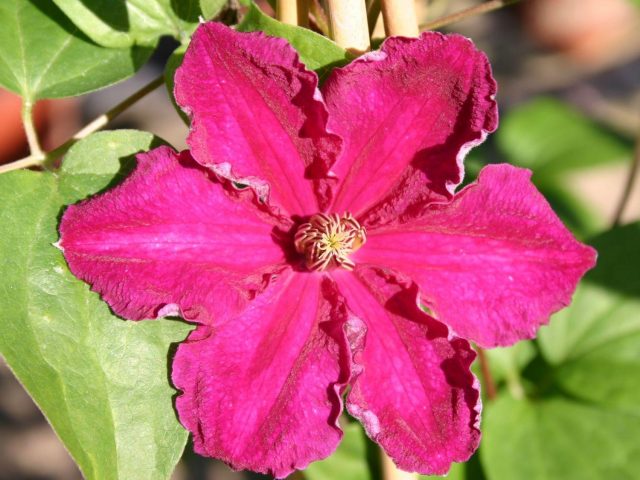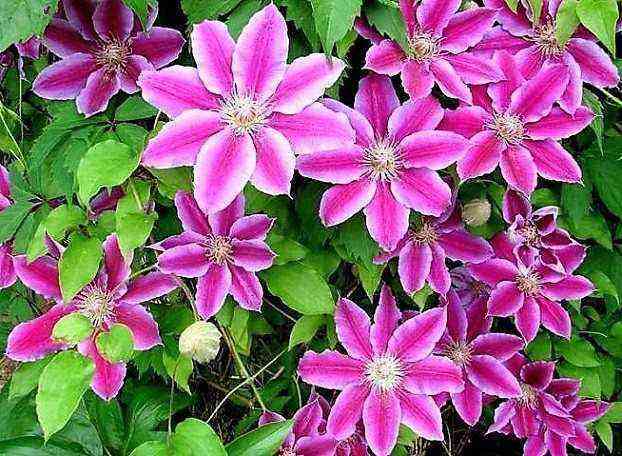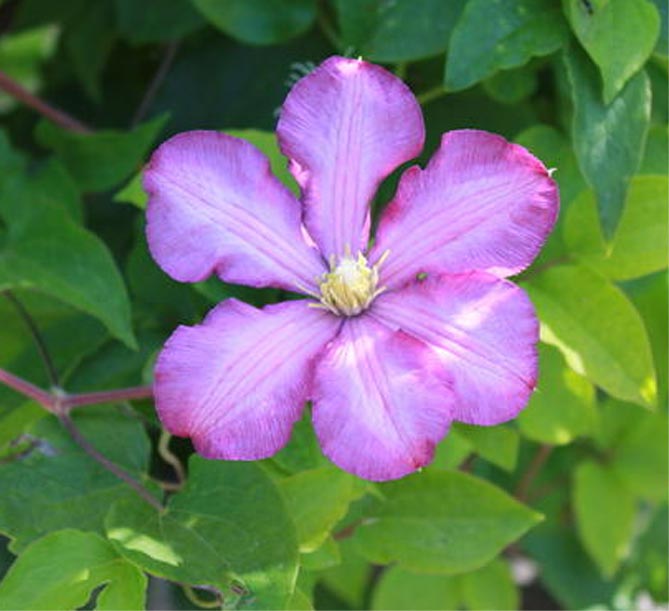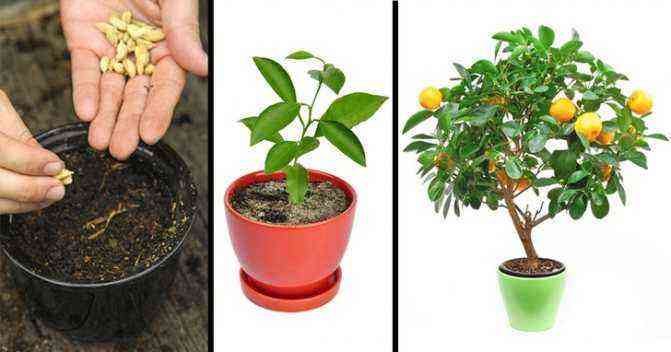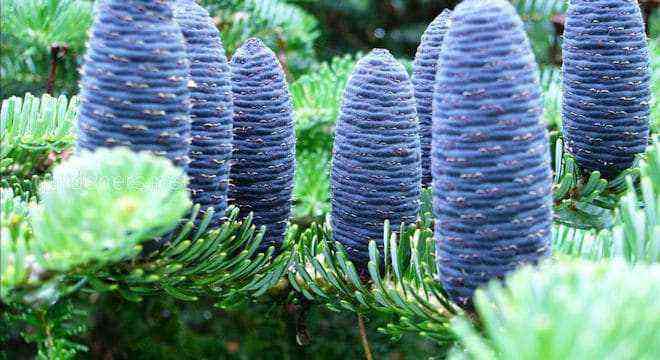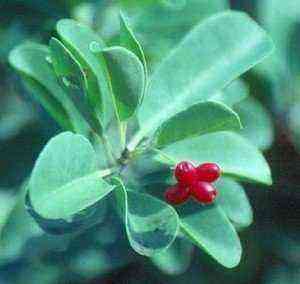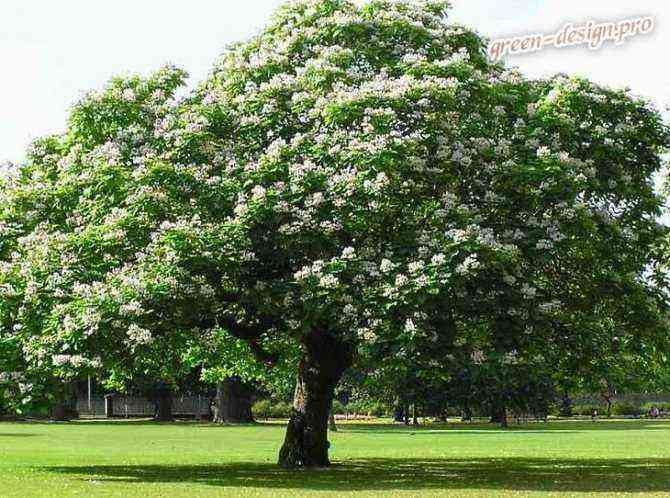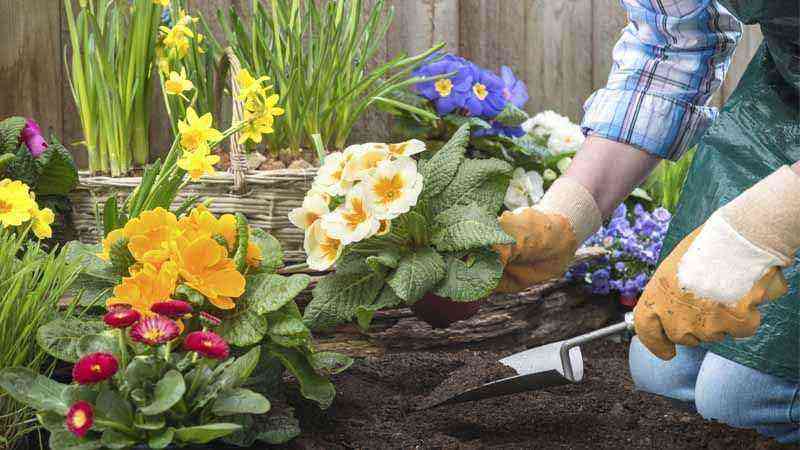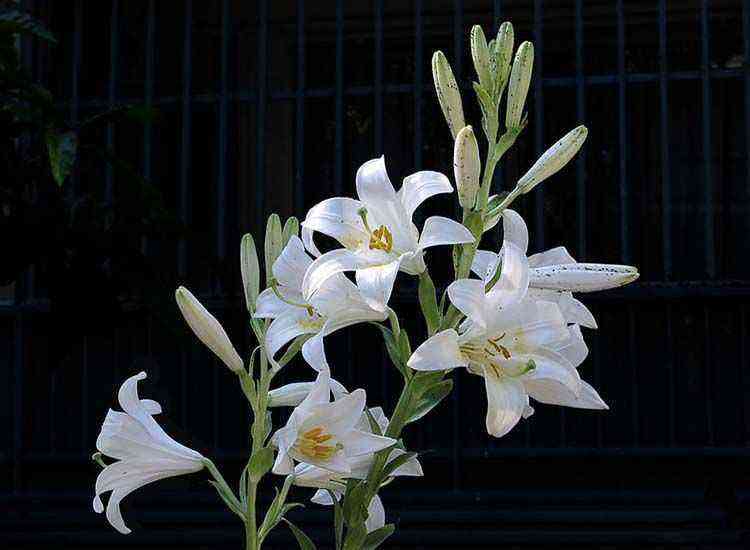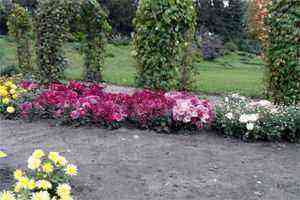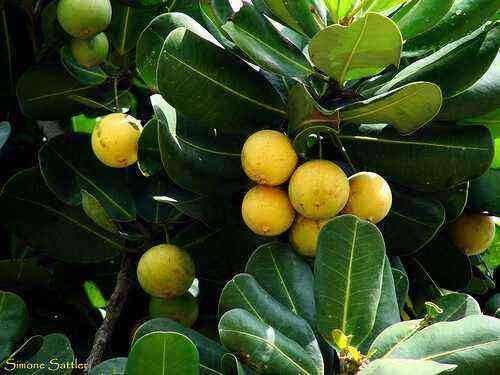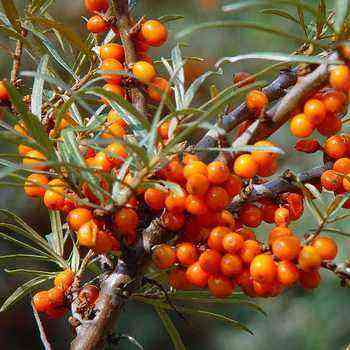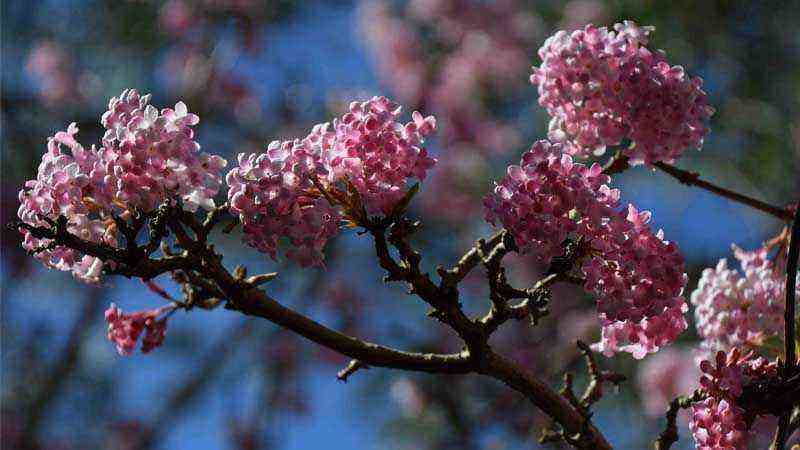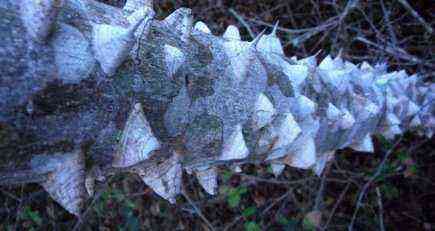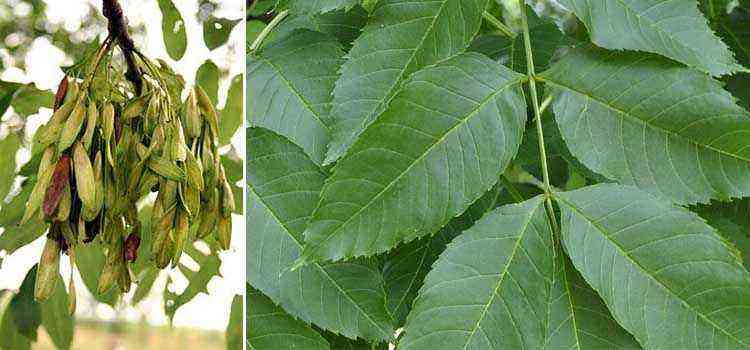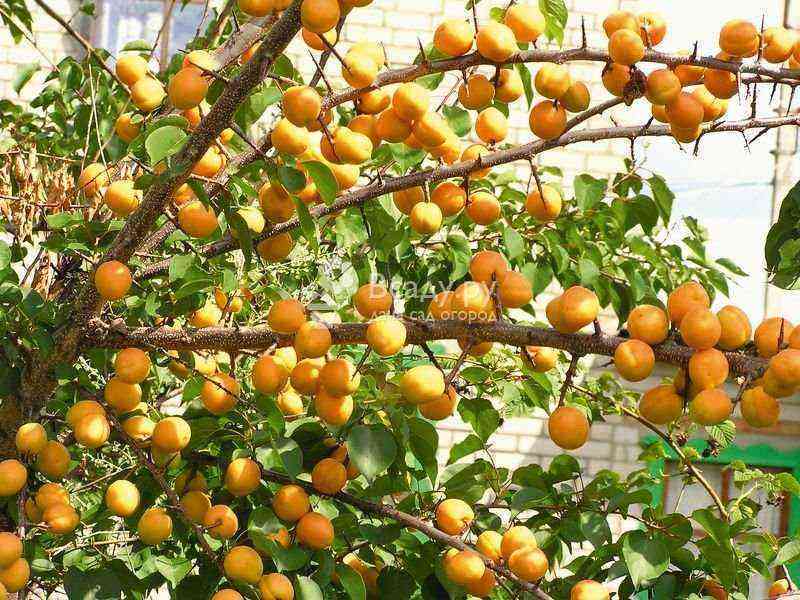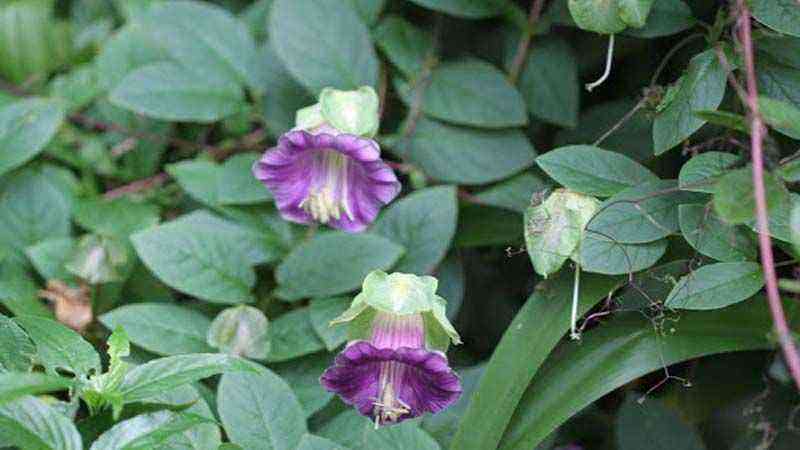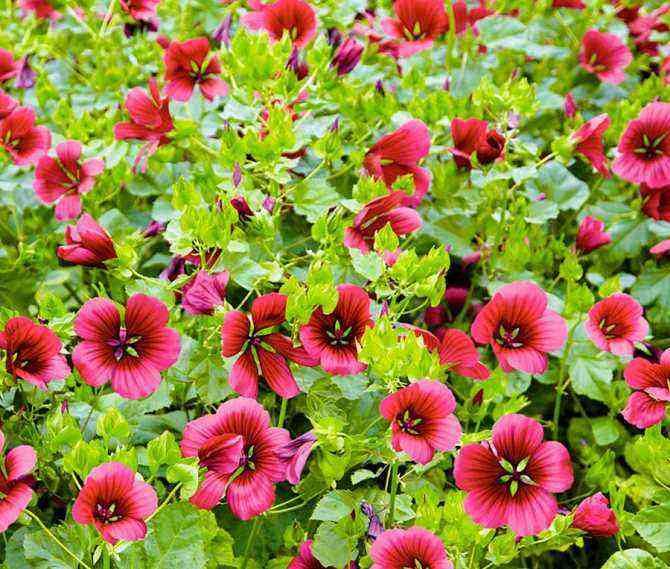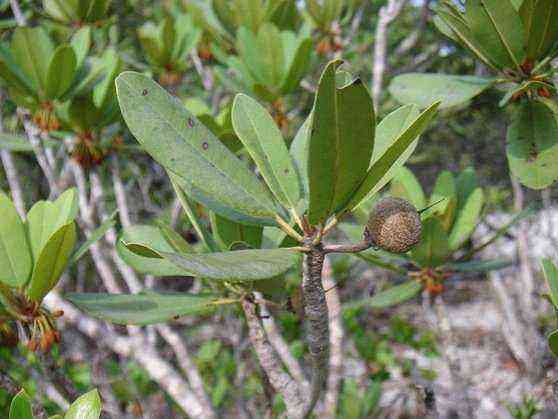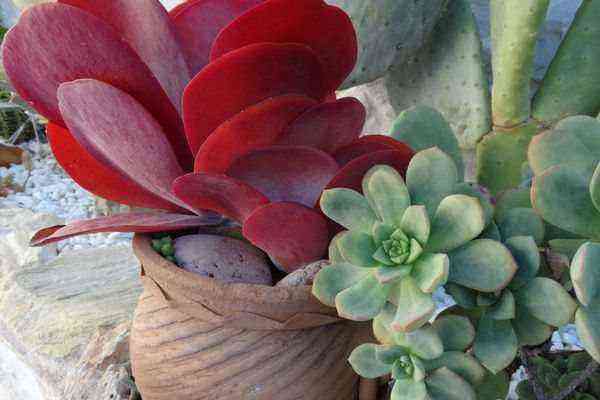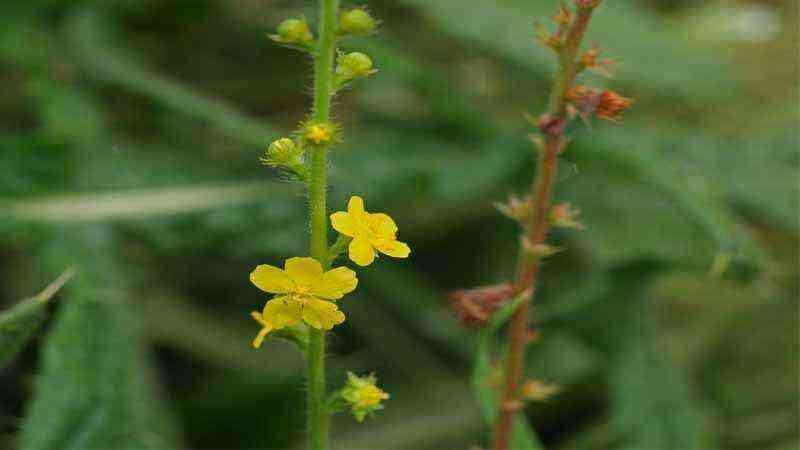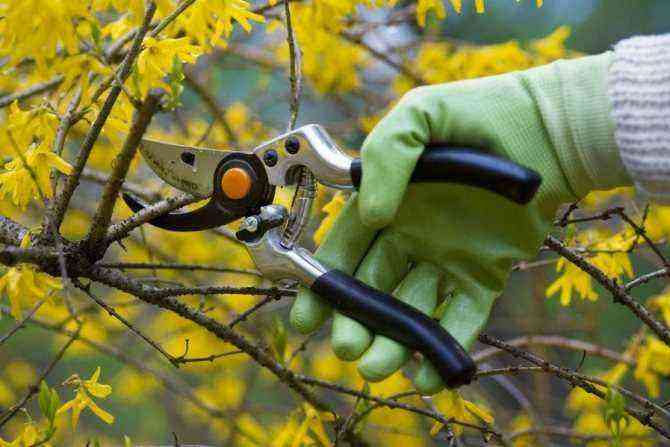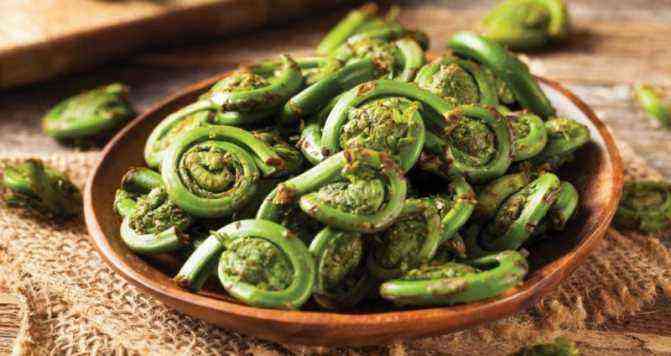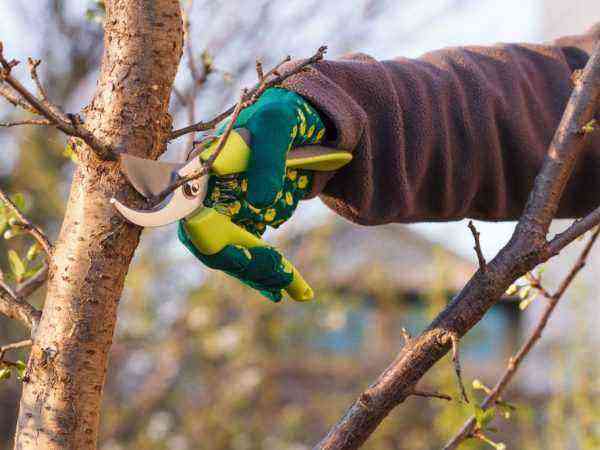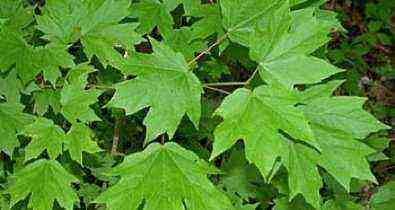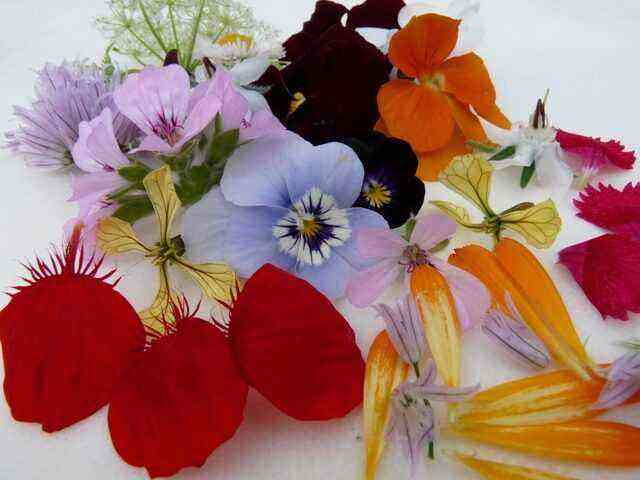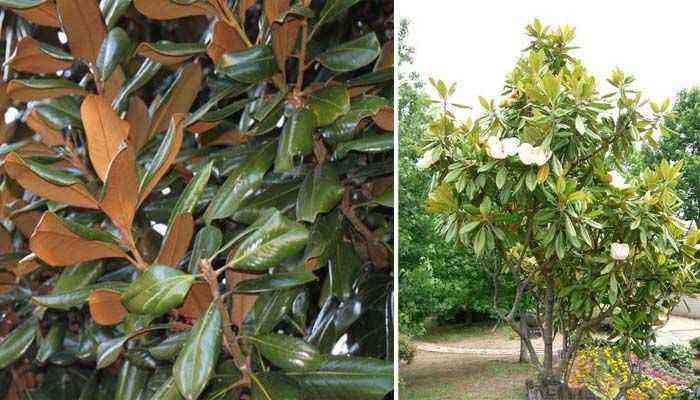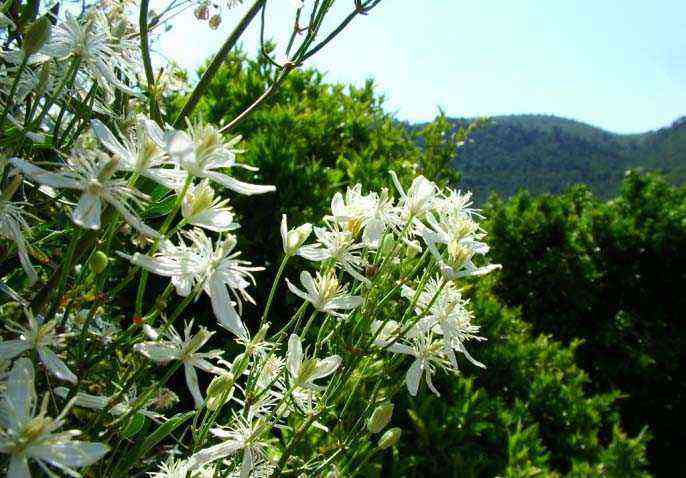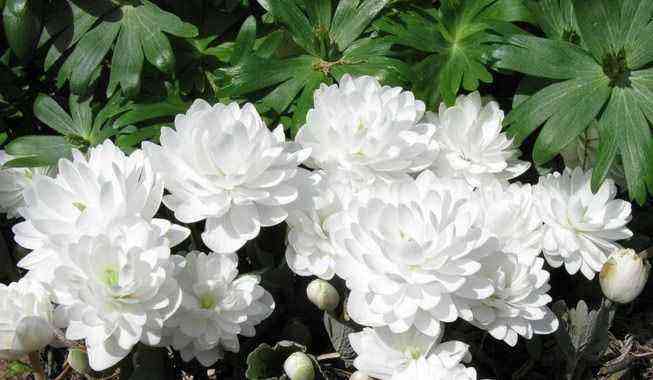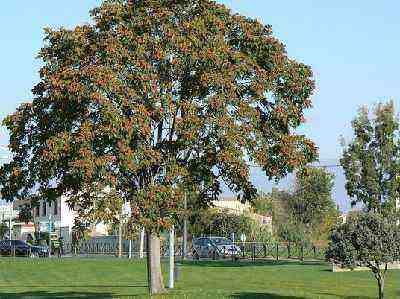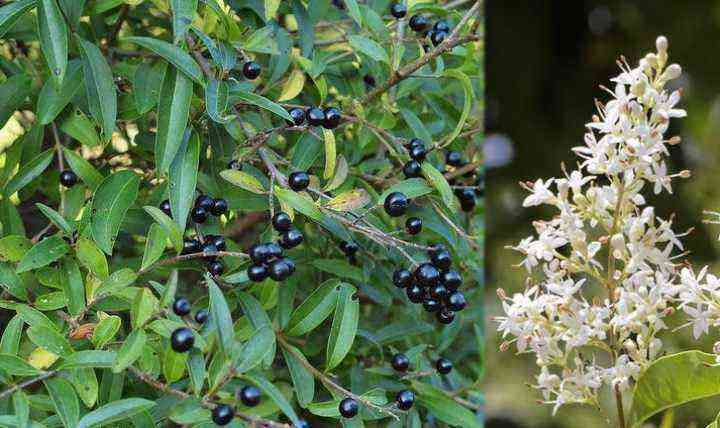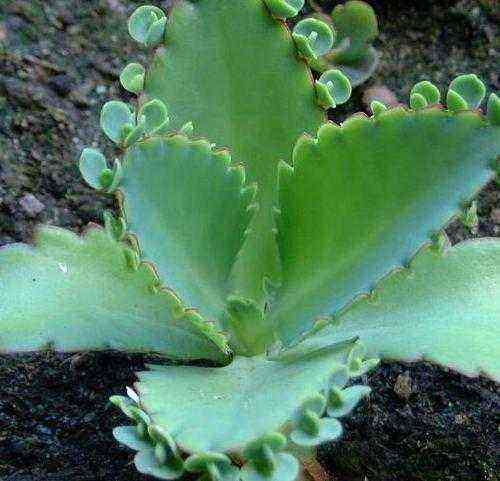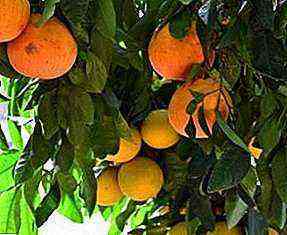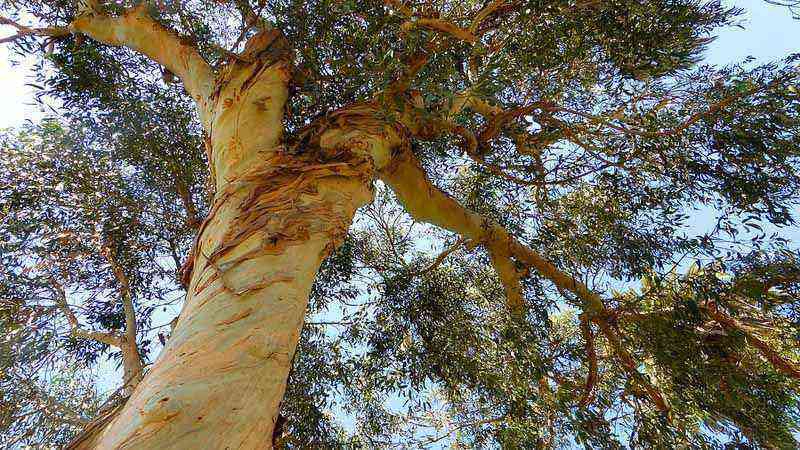Clematis is an amazingly beautiful plant that combines power, rapidity of development, lush foliage and long, abundant flowering. The plant can show all its beauty and dignity if it is properly looked after in its garden area.
Clematis is a famous sun lover. Planted in partial shade, it will not remind you of the “king of lianas”, as it is often called. There will be flowers, but small and rare. We will consider these and other points later in this article.
Botanical description of clematis species
Clematis – clematis, vine. Buttercup families – Ranuncuiaceae Juss. The genus has 230 species. Various types of clematis are found in the temperate zone of the northern hemisphere. The genus unites types of various life forms:
- Treelike climbing plants with shoots from 1.5 to 10 m high
- Treelike shrubs with straight shoots up to 1.5 m high
- Herbaceous perennial plants with straight shoots from 0.4 to 1.5 m in height
Clematis leaves are opposite, whole, trifoliate, double trifoliate or pinnate.
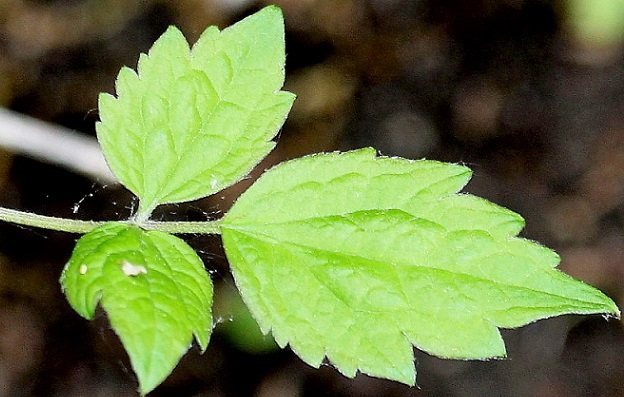

Flowers are collected in inflorescences, rarely single; bisexual or dioecious, variously colored; flowers without petals, consist of 4 – 8 petal sepals.
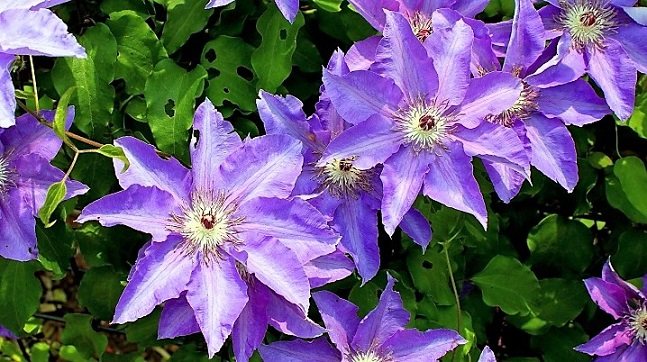
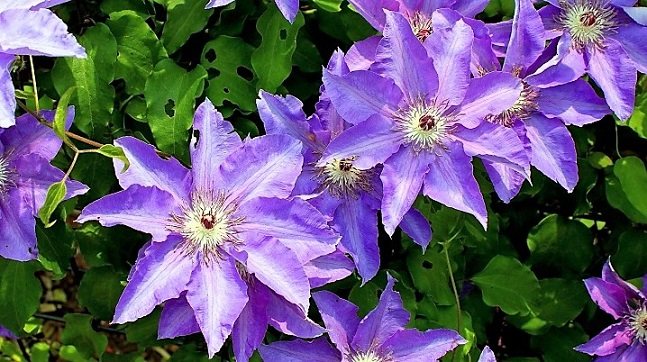
Achenes are numerous, collected in a head, at the end with a short or long pinnately pubescent column.


Next, we will consider and get acquainted with all existing species in more detail.
Description of the plant
Clematis (Clematis), otherwise known as Clematis, is a broad group of climbing perennial plants, covering thousands of varieties. Because of the flower’s appearance, vigor and requirements, not all varieties have gained popularity. In wide cultivation, about 250-300 varieties are used for various purposes:
- decoration of fences;
- gardening of gazebos, terraces;
- growing in open areas in the garden;
- use as cover crops.
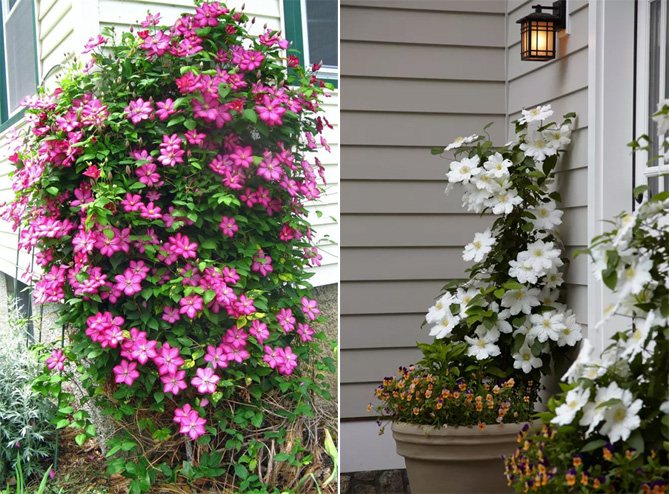

Typically, varieties are derived from any of the species described below (or hybrids formed from them). It is difficult to imagine a beautiful garden without wonderful varieties of clematis. Hybrids with large flowers are especially popular, the main flowering period of which occurs in May-June. Less known are the so-called botanical varieties. Many of them bloom at a time when hybrids take a break from flower development.
Due to the different flowering times, you can create such a composition of clematis in the garden, which will allow you to enjoy their beauty from April to October. Choosing from a large number of clematis species, hybrids and varieties is undoubtedly very difficult. In the beginning, it is important to determine the size of the flowers and the season of flowering.
Clematis blooming in spring are pruned in June after flowering. Summer varieties are pruned in September. Autumn varieties require pruning in the spring.
Although the varieties of clematis are very diverse, they all have the same requirements: “feet in the shade, head in the sun” and regular pruning according to belonging to a particular group.
Brown Clematis (Clematis fusca Turcz)
Homeland – the Far East, Japan, China. Grows in meadows and coastal forests. Clematis is a semi-shrub liana up to 2 meters high with pubescent young shoots, especially at the base of leaf petioles. Leaves with 5 – 7 leaves; leaflets from ovoid to oblong-ovate, 3 – 7 cm long, gradually pointed, rounded or cordate at the base, entire, serrated or dissected into 2 – 3 lobules, glabrous or pubescent underneath.
Flowers are solitary, ur-shaped, drooping, on thick short stalks, with 4 – 6 sepals. Sepals are oblong-ovate, 2 – 2.5 cm long with slightly curled ends, dirty purple, brown, red or brown, brown-haired or almost glabrous above, and white-pubescent only along the margin, glabrous on the inner side.


Achenes broadly lanceolate, flat, pubescent, with a feathery, brown-yellow-pubescent nose, up to 3 cm long.
Propagates well by seeds, layering and green cuttings. It is used in vertical gardening for the design of low structures. It is appreciated for its original flowers, massive and long flowering.
Grape-leaved Clematis (Clematis vitalba L.)
Distributed in Central and Southern Europe, Crimea, the Caucasus, Asia Minor, North America. Clematis grows in deciduous and mixed forests, thickets of shrubs, on rocky slopes, climbing mountains to a height of 1200 meters. This is a powerful woody liana up to 10 meters high. The stem is strongly ribbed, later fissured-furrowed, with a separating gray-brown bark.


Young shoots are hexagonal, greenish-brown, strongly pubescent at the nodes. Leaves are pinnate; leaflets are usually 3 – 5. They are ovate, ovate-lanceolate or oblong-lanceolate, with a pointed apex and a slightly cordate or rounded base. On the edge, the leaves are coarsely toothed or lobed, bright green, sparsely pubescent along the veins, 3 – 9 cm long, 2 – 6 cm wide.
The flowers are numerous, weakly aromatic, bisexual, with four sepals. Sepals are off-white, shortly pubescent, 1.5 cm long, 7 mm wide. The flowers are collected in complex flowering inflorescences with small green leaves in the branches of the axis.


The fruit is a doubly convex, almost rounded achene 2 – 3 mm in diameter with a long pubescent column up to 4 cm long. It blooms from July to September. The seeds ripen at the end of October – November.
Shoots are cut annually to a height of 1.5 – 2 meters. For 1.5 – 2 months, young shoots grow up to 4 meters and bloom profusely in the same year. It propagates well by seeds.


In vertical gardening, it is valued for its fast growth, dense foliage, abundant and long flowering and a mass of pubescent seed bolls. Applicable in any vertical gardening: in the south – up to 10 meters, to the north – up to a height of 4 – 6 meters.
Eastern Clematis (Clematis orientalis L.)
Distributed in Mongolia, China, Asia Minor, Crimea, the Caucasus, Central Asia. It is a woody liana up to 6 meters high. The stem is ribbed, sometimes reddish, the leaves are bluish-green, pinnate or double-pinnate. The lower leaves are usually three-fold trifoliate, sometimes five-lobed or trifoliate.
Leaflets are oval to oblong-oval or lanceolate, 1.5 – 5 cm long. Lobes are coarsely toothed, smooth or pubescent, usually triple-dissected into two lateral short and middle longer lobules. Slices whole-edged or serrated, obtuse or pointed.
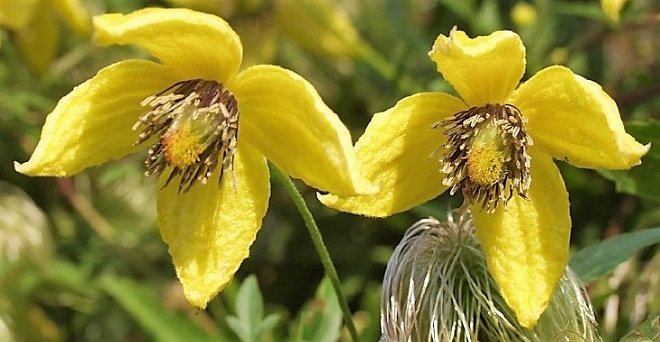
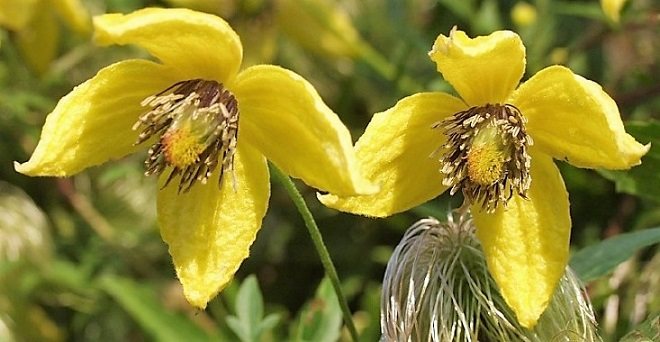
The flowers consist of four sepals, 3 – 5 cm in diameter, on thin pedicels 4 – 10 cm long. The flowers are located in the axils of the leaves in small paniculate inflorescences. Sepals yellowish, reddish outside, on both sides short-tomentose-pubescent, oblong-lanceolate, long-pointed dorsally, wide-open and hooked-twisted back.

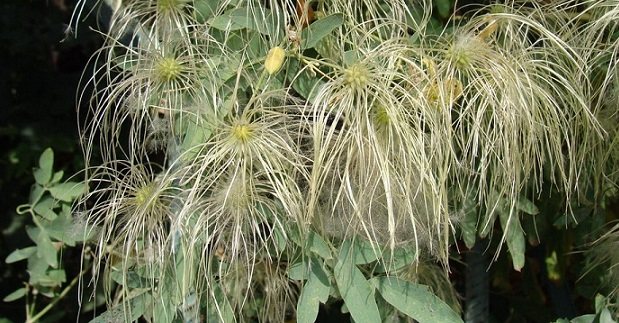
Achenes are compressed, with thickened edges, pubescent, with a pinnately pubescent column more than 5 cm long. Blooms in August – October. The seeds are harvested in November. It propagates well by seeds. It is used in vertical gardening.
Clematis durandii Kitze
It is known as a semi-shrub vine with stems up to 2 meters tall. Leaves are simple, ovate or pinnate. Leaf lobes 8 – 12 cm long, wide, cordate at the base, sometimes elongated. Leaf petioles 2 – 5 cm long.

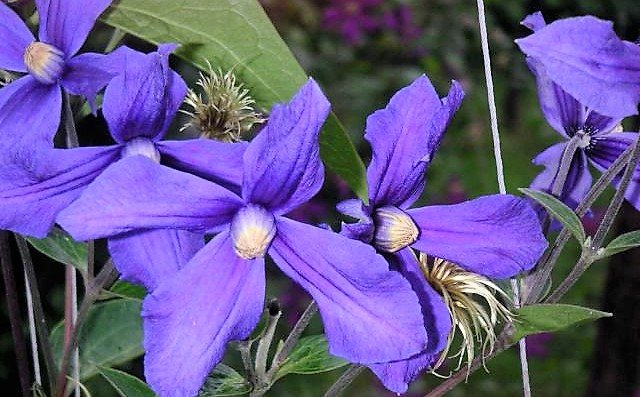
Flowers 8 – 12 cm in diameter, mostly dark purple-blue with various shades, sometimes white. Sepals 4, less often 5 – 6, they are thick, dense, elastic, wide open. The stamens are mostly bluish-yellow, the pistils are strongly pubescent. Blooms from June until frost.
Fruits are rounded flat achenes up to 5 mm in diameter and with a long (up to 2.5 cm) pinnate nose.
When planted deeply, it is cultivated without shelter for the winter. The stems freeze annually to ground level, and in the spring from the buds preserved in the ground, powerful young shoots grow, which bloom in the same year. Propagated by dividing the bush, layering, cuttings and grafting.
It is used in any design of group and single plantings on lawns and on supports up to 2 meters high. From this hybrid, varieties with blue and white flowers are distinguished. The most interesting of these is:
Variety “Anastasia Anisimova”.

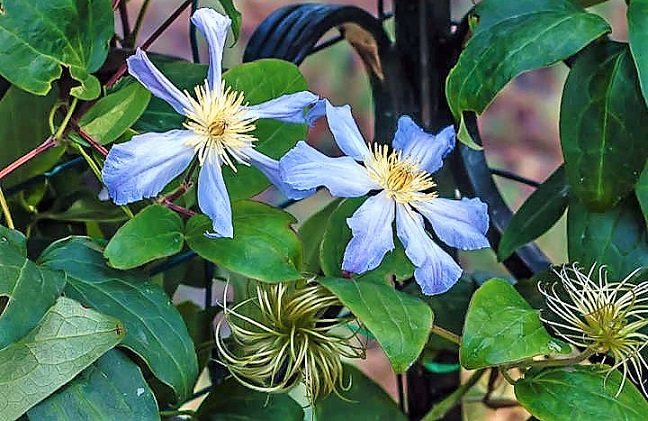
Bred by A.N. Volosenko. Stems up to 2 meters tall. Flowers 10 – 12 cm in diameter, wide open, 6 – 8 sepals, rarely 4, pure blue, whitening towards the center, with a slight shade of smoky crystal. Anthers are large, bright yellow. Blooms from June until frost.
Large-flowered
This is the most popular, beautiful and demanding group, including varieties with flowers reaching 15-25 cm in diameter. Most often they bloom on last year’s shoots in May and early June. Later, they can repeat flowering on young shoots. Unfortunately, large-flowered clematis are not very resistant to drought and frost. They require cover.
Large-flowered clematis are the most beautiful clematis, they have large and bright flowers, they bloom for a long time and abundantly. Many varieties have been developed, and their number is growing. Every year, new varieties are created, which are characterized by more and more new colors in different shades.
Flowers are simple, semi-double and double, they take almost all colors (except black and green:
- white,
- yellow,
- pink,
- red,
- Violet,
- blue (in different shades).
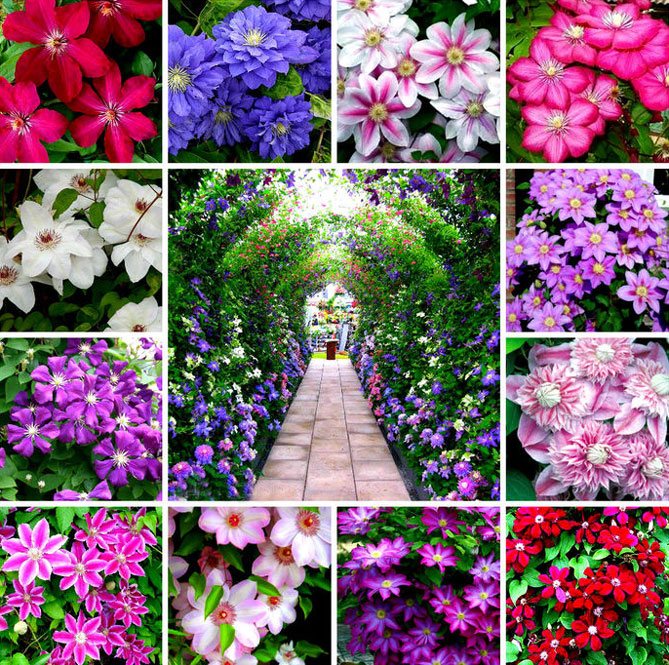
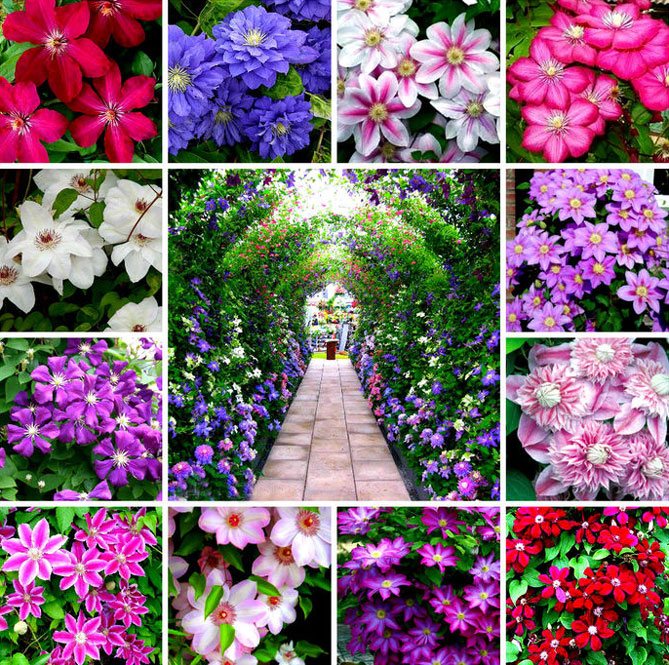
There are also bicolor and striped flowers. The varieties differ significantly from each other in growth strength, requirements and flowering times.
Distinguish between early flowering and late varieties.
Flowering classification
Early
Flowering begins in mid-May on last year’s shoots, often repeating flowering in summer on the shoots of the current year, flower size 15-25 cm, growth – 2-3 meters.
White or cream
| Variety, photography | Color, flower size | Flowering time | Height how to grow |
| Guernsey Cream | Initially light yellow flowers with a green stripe, later white, 12-15 cm | first: V-VII, repeated – VIII | Short, requires light pruning, recommended for pot cultivation. |
| Mrs George Jackman | White inflorescences, 10 cm | XNUMX-XNUMX | 2 meters, can climb on natural supports, does not require heavy pruning |
| Ballerina | White inflorescences, 15 cm | V- IX | 3 meters, the variety is suitable for the Moscow region |
Red
| Variety, photography | Color, flower size | Flowering time | Recommendations |
| Hope (Nadezhda) | Burgundy, star-shaped, 14 cm | V-VI | 2,5-3 meters, suitable for the Moscow region |
| Niobe | Numerous, dark red, fantastically contrasting with the green, dense carpet of leaves, 12-15 cm | First – VI, repeated – VIII-IX | 1,5 meters |
| Westerplatte | Intensely red, velvety flowers with a stripe in the center, 15 cm | The first is VI, the second is VIII-IX | Grows moderately fast, clinging to supports, reaches 2 meters. |
| Rouge Cardinal | Large, scarlet red flowers. In sunny positions, the intense color of the flowers will become cloudy, 10 cm | V-IX | Strong pruning for the winter |
Pink
| Variety, photography | Flower color, diameter | Flowering time | Height, recommendations |
| Nikolay Rubtsov (N. Rubtzov)
| lilac, 17 cm | V-VIII | 2,5 meters, suitable for the Moscow region |
| Какио (Kakio) | Dark pink with a light central stripe and contrasting golden stamens, 10 cm | summer | Compact. An excellent plant for small gardens. |
| Piilu | Lavender pink, first double, second simple in July-August, 10-12 cm | First – VI, repeated – VIII | The compact size of the bush. The plant variety is suitable for small gardens. |
| Dr. Ruppel | Large red-pink. Strong sun leads to wilting of flowers, 10-15 cm | First – V, repeated – VIII-IX | Sanitary pruning after overwintering |
| Kaiser – large vine from Japan | Terry dark pink, 15 cm | V-VI | Frost-resistant plant without special requirements |
| Innocent Blush | Large, pale pink and semi-double, 12-18 cm | First – V, repeated – VIII | 2-3 meters |
| Clematis asao | Bicolor flowers, intense pink, with a white stripe in the middle, the most intensely colored at the edges, 15 cm | V-VI, then VII-IX | 2-3 meters |
| Clematis Tudor | Beautiful starry flowers of delicate pink color with a purple stripe running through the middle | Blooms once, early and long V-VIII | 1-1,5 m |
Blue
| Variety, photography | Flower color, diameter | Flowering time | Height, recommendations |
| Fujimusume – variety from Japan | Large, bright, azure blue flowers with yellow anthers, 10 cm | summer | Considered the most beautiful of the blue clematis |
| Diamond Ball | White and blue flowers, petals arranged symmetrically, 10-12 cm | Flowering: VI-VII, repeated – VIII | 2 meters |
Purple
The President is a decorative loach with large flowers that blooms profusely. Grows moderately fast, the length of the vine is 2,5 meters. Bright purple flowers with a stripe in the middle of each petal, about 17 cm in diameter. One of the earliest and fastest growing varieties. Flowering: V, repeated – VIII-IX.
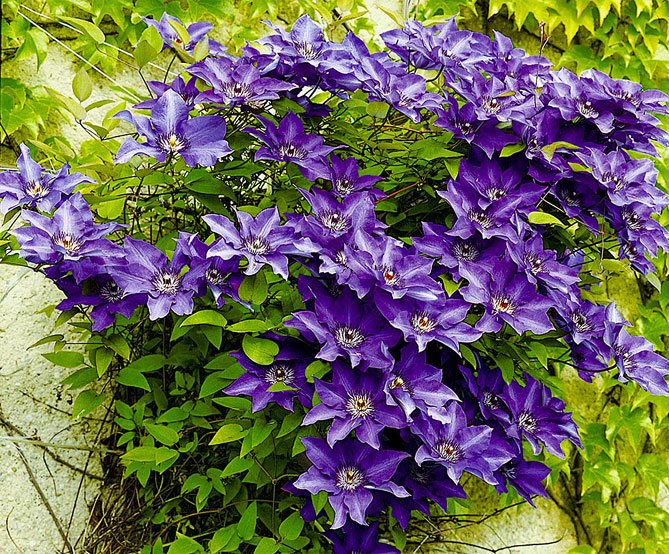
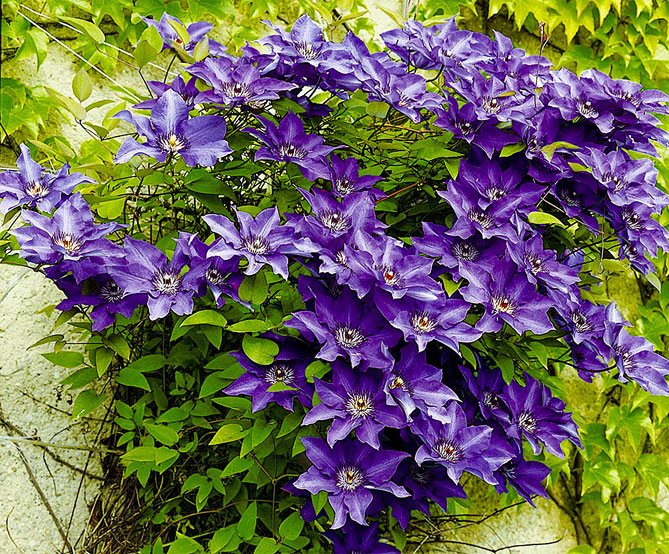
Late flowering
The beginning of flowering from mid-June, flowering on the shoots of the current year, often repeat flowering in late summer or autumn, flower size 13-20 cm, shoot growth – 2-3,5 meters.
White or cream
| Grade | Flower color, diameter | Terms of flowering | Height, growing features |
| Khaldin (Huldine) – a beautiful blooming vine, 3-5 meters high | Pearl white with yellow centers. It blooms better in sunny, well-lit places, 8-10 cm. | June-September | 3-5 meters, requires strong pruning in the first year in early spring |
| John Huxtable | Decorative white flowers with bright yellow stamens, 8-10 cm | VII-IX | 2-3 meters, can climb on natural supports |
Red
- Ernest Markham – The variety has bright red, large flowers that adorn the plant from July to October. Grows best in sunny locations.

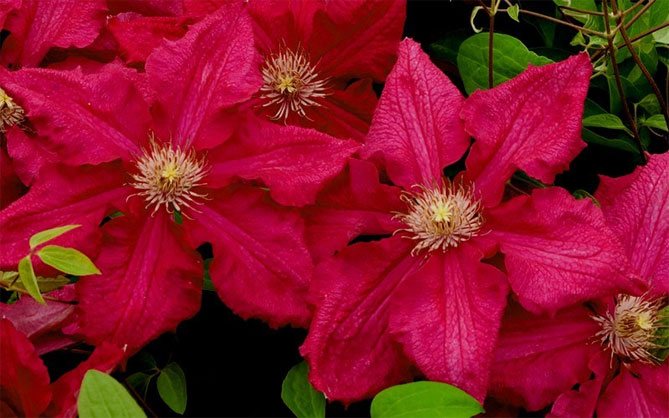
- Clematis whole-leafed Mazowsze variety was bred in 2006 in Poland. It has large (15-20 cm in diameter), burgundy flowers that adorn the plant from late June to September. It grows quite strongly up to 2-3,5 m in height. Requires a sunny or semi-shaded position. It tolerates most soils, but grows best in moist, fertile, permeable soils with neutral to slightly acidic pH. Recommended for planting among perennials, in gazebos, on other garden supports. Frost-resistant grade.


Pink
| Grade | Flower color, diameter | Flowering season | Height, development features |
| Comtesse de Bouchaud | Light pink with intense yellow anthers, 10-12 cm | VI-IX | 3-4 meters |
| Hagley Hybrid | Pale pink with chocolate brown anthers, 13 cm | VI-IX | 2-3 meters, requires strong pruning in early spring |
Blue
| Variety, photography | Flower color, diameter | Flowering period | Height, growth features |
| Anastasija Anisimova | Light blue, 10-13 cm | July-October | 2,5 meters The variety is suitable for Siberia |
| Blue Angel | Light blue with a white serrated edge, 10-12 cm | June August | 3 meters |
| Ramona | Blue flowers with purple stamens, 10-12 cm. Excellent variety for hot, sunny places. | June August | 2,5-3 meters |
| Ascotiensis | Blue with 4-6 corrugated petals, 15 cm | July-September | 2,5-3 meters |
Purple
| Variety, photography | Flower color, diameter | Flowering period | Height, growth features |
| Gipsy Queen | purple-violet, blooms much weaker in the shade, 12 cm | June-September | strong growing |
| Jackmanii | Dark blue-violet with contrasting greenish-cream anthers, 15 cm | June-September | 2 meters |
| Etoile Violette | Dark purple, 12 cm | June-September | Strong growing, 3-4 meters. Suitable for the Leningrad region. |
| Victoria | Violet with greenish-yellow anthers, 10-12 cm | July-September | 2-3 meters, resistant variety |
| Clematis Viola | Deep purple, velvety flowers, planted on long stems. Yellow-green stamens, 10-14 cm | June August | 2-3 meters |
Curly and bush large-flowered
Jacqueman’s group and its hybrids (Clematis × jackmanii Moore)
Clematis of the Jacquemann bush group has large flowers (8-10 cm) blue, purple, white, pink or carmine. Often the petals are slightly striped or veined and slightly pubescent. The height of the vine is 2-3 meters. Not entirely frost-resistant, for the winter you need to spud like a rose. Clematis Jacques should grow in a secluded place, protected from the winds, the soil should be fertile, humus, slightly limestone.
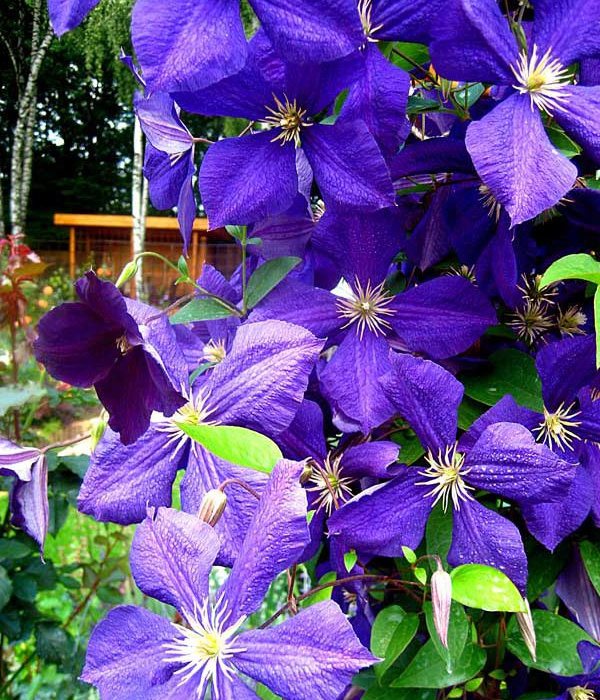

Integrifolia or Clematis Interifolia
Description of whole-leaf clematis: produces delicate flowers and reaches a height of 2 meters. It is a perennial plant. Shoots need good support. It blooms late, requires heavy pruning and low maintenance requirements. Quite resistant to drought and frost.
Italian (purple) clematis Viticella (Clematis viticella)
It grows strongly (shoots 3-5 m long), quite frost-resistant, not picky. The main form has large, purple bell-shaped clematis flowers. Climbing plants of the Viticella group bloom in summer and autumn on the shoots of the current year. Requires strong pruning and a sunny location. Not picky about the type of soil. Recommended for planting along mesh fences.
Clematis Jackmanii The Moore
It is an interspecific hybrid obtained in 1860 in England by Jacqueman from crossing woolly clematis with purple clematis, from which a large number of highly decorative varieties have been bred.
Externally, these are woody vines with stems up to 4 meters. Stems hexagonal, ribbed, internodes evenly, and nodes densely covered with long hairs. Leaves are unpaired pinnate, consisting of 3 – 5 leaflets. Leaves from ovate to broadly ovate with a cordate base, short-sagging from below, sitting on petioles up to 3 cm long.
Flowers 8 – 15 cm in diameter, wide-open, of various colors, collected in 3 pieces on thin, long (up to 8 – 12 cm) pedicels with two leaf-shaped bracts. Sepals 4, sometimes 5 – 6. They are oblong, obovate broadly ovate with wavy edges, glabrous above, densely short pubescent below.
Filaments are shorter than anthers, sometimes pubescent at the base. Pistils are smooth or sometimes pubescent from the middle upwards.
The fruit is a large, rounded achene up to 8 mm in diameter, flat, along the edge with a thickened border and a long (up to 30 mm) pinnate nose. Blooms from June until frost.
Clematis propagates by dividing the bush, layering, lignified and green cuttings, grafts and rarely seeds. To obtain seeds, it is necessary to carry out artificial pollination with the pollen of some wild species. Seeds sprout in 10 – 19 months. When propagated by seeds, strong splitting occurs without preserving the maternal form.
As exceptionally highly decorative lianas, they are widely used for vertical gardening, in the open field and in tub culture, not only in the southern regions, but also in the more northern ones up to St. Petersburg. For review, varieties with large flowers of various colors are provided:
Variety – Andre Leroy


Flowers up to 12 cm in diameter, at first dark purple, opened – purple with a whitish marble strip in the center of the sepal. Sepals 4 – 6.
Variety – Zhakman (Jachmanii)

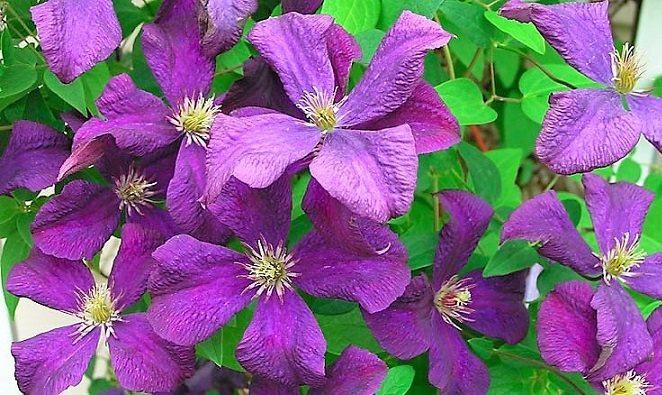
The variety was bred by Zhakman. An interspecific hybrid was obtained in 1860 by crossing C. lanuginosa with C. viticella. The flowers are dark purple-blue, up to 14 cm in diameter. Sepals 4.
Variety – Cipsi queen
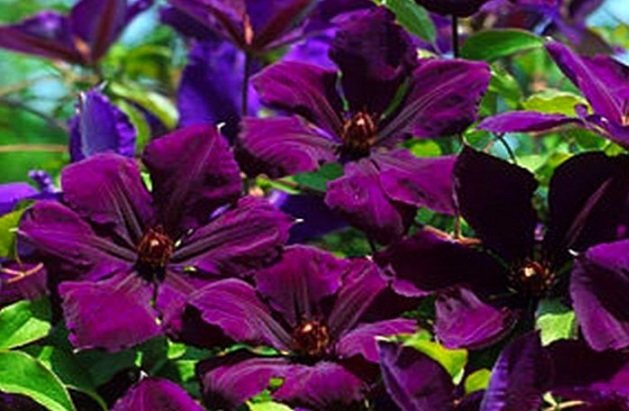

Bred by Kripsom. The flowers are deeply dark blue, up to 12 cm in diameter. Sepals 5 – 6.
Variety – Jadviga Walenis
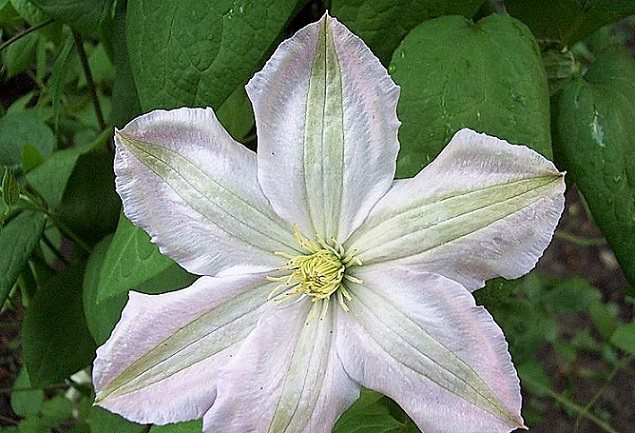
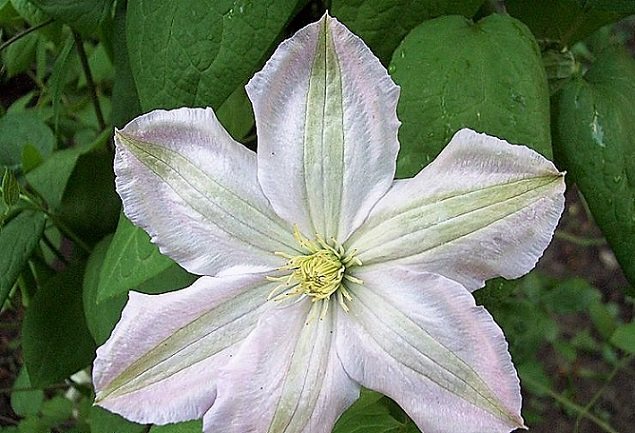
Bred by A.N. Volosenko. The flowers are white, up to 12 cm in diameter.
Synonyms: jackman’s lomonos, Jackman’s clematis, Clematis × jackmanii var. rubroviolacea Regel
Clematis grape-leaved (Clematis vitalba L.) is a species of perennial woody plants from the Clematis genus of the Buttercup family. It is an interspecific hybrid of woolly clematis, red clematis violet and an early garden hybrid Clematis × hendersonii. The hybrid was obtained in 1858 at the famous Jackman & Sons nursery in Woking, Surrey, England. It was first described by George Juckman together with T. Moore in 1872 in the monograph “Clematis as a Garden Flower”, which was dedicated to Princess Mary, Duchess of Tack, and how this flower was her favorite. In culture since 1862.
It is a woody shrubby powerful liana up to 3 (4,5) m in height. Forms a stem in one growing season. It rises to the support with the help of twisted leaf stalks. The stem is brown-gray, ribbed, pubescent.
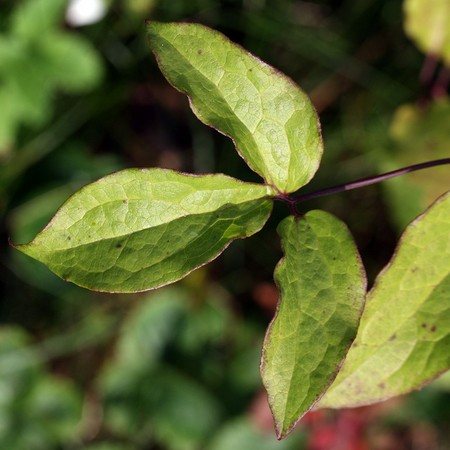

Leaves are compound, pinnate, consist of 3-5 leaflets, often simple in the upper part of the stem. The leaves are 5-12 cm long, ovate or broadly ovate, pointed, cordate at the base, glabrous above, dense green, light and slightly pubescent below, pale green. Petioles up to 3 cm in length.

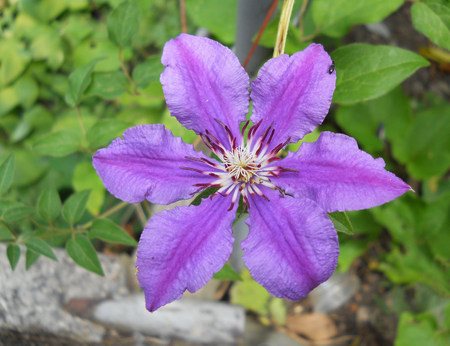
Flowers arise from the first to the seventh axillary nodes on the shoots of the current year. Collected in 3 pieces in axillary half-umbrellas, 10-12 cm in diameter, velvety, purple-purple or pink, wide open. The perianth is disc-shaped or cruciform. Tepals 4-6 pieces, up to 6 cm long, broadly obovate, pubescent outside. There are 4 sepals, they are obovate broadly ovate. Filaments are short or unequal in length, rarely slightly pubescent in the lower part. Blooms from May to September, profusely, for a long time. Flowers are odorless.
Fruit – achenes with 1 capsule for seeds. Seeds with a feathery tail 2-5 cm long with silky hairs. Seeds are practically not set without artificial pollination.
Sorts: André Leroy, Contes de Bouchard, Gypsy Queen, Madame Baron, Weylard, President, Alyonushka, Anastasia Anisimova, Cosmic Melody, Moonlight, Luther Burbank, Fantasy, Jacquemani Rubra, Star of India. These are varieties of the mother plant of which Clematis Zhakman is.
In the modern classification, the group of Zhakman’s clematis also includes a subgroup of Late Large-flowered, which includes varieties of a different origin. This was done because many intervarietal hybrids appeared, which are difficult to attribute to any group. The common feature of these varieties is flowering on the shoots of the current season from June or July, as well as the need for low pruning. The most popular of them are Ville de Lyon, Barbara Harrington and Rouge Cardinal.
There is also a subgroup of Large-flowered early, in which varieties that bloom profusely in May-July on the shoots of last year were combined. Common – Anna German, Barbara Jackman, Josephine, HF Young, Multi Blue, Nelly Moser, Piilu, The President. New items – Ice Blue, Grefve Erik Ruuth, Julka, Kingfisher, Rosemoor.
Frost resistance zone: 4a (-29 ° C)
Area information: prefers sufficiently moist, humus-rich, loose neutral or alkaline soil. Grows well in sunny places, even in the southern regions. Drought-resistant.
Landing: Clematis seedlings are planted in spring. The dimensions of the planting pit are 60x60x60 cm.The soil mixture – the top layer of soil is mixed with 2-3 buckets of compost or humus, 1 bucket of peat, 1 bucket of sand, 100-150 g of superphosphate, 200 g of complete mineral fertilizer, preferably 100 g of bone meal, 150 -200 g of lime or chalk, 200 g of ash. When planting in light soils, it is recommended to add more peat. If the soil is wet, clayey or dense, it is necessary to pour 1015 layers of rubble for drainage. In the southern regions, planting is carried out in late September – early October, in the middle lane – in September, in the northern – in the spring (late April or early May) or early autumn. Can be planted in containers throughout the growing season. When planting in groups, the distance between plants should be at least 1 m. When planting in autumn, the planting material should have developed vegetative buds, in spring planting – at least one shoot. The seedlings must have at least 3 roots less than 10 cm long.
Care: in early spring, clematis can be watered with milk of lime (200 g of lime per 10 liters of water per square meter). In a dry hot period, it is necessary to water the plant not often, but abundantly, while not hitting the center of the bush with a stream. Clematis are fed at least four times per season after irrigation with full mineral fertilizer with microelements at the rate of 20-40 g per 10 liters of water or diluted fermented mullein (1:10). Mineral and organic dressings alternate. In the summer, once a month, plants are watered with a weak solution of boric acid (1-2 g) and potassium permanganate (2-3 g per 10 liters of water), and the bushes are also sprayed with urea (0,5 tablespoons per 10 liters of water). In the spring, after fertilizing and watering, it is recommended to mulch the soil with peat or humus (northern regions) and sawdust (southern). To protect against overheating, letniki can be planted near clematis.
Trimming: Clematis Zhakmana blooms on the shoots of the current year. The first pruning must be carried out at the beginning of summer; for this, weak shoots are cut to enhance flowering on the main shoots. After that, at the end of June 13 or 14, part of the shoots is cut over 3-4 knots to extend the flowering period. After this kind of pruning, shoots of the second order grow on the upper buds of the upper nodes, from which new flowers appear after 45-60 days. After the first frost, all shoots are cut at a height of 0,2-0,3 m above ground level. Without such pruning, vines are highly susceptible to disease and bloom worse.
Reproduction: during seed propagation, varietal characteristics are lost. Propagated by dividing the bush in October or late April – early May. It propagates by layering in autumn or spring – from last year’s shoots, in July – with new shoots. Propagated by green cuttings in June-July. Lignified cuttings are taken from the shoots cut off in the fall (the cuttings are stored in boxes in the basement until spring). Grafts propagate well on the roots of 2-3 year old varietal clematis of other species (for example, purple clematis.
Diseases: Gray rot, powdery mildew, rust, wilt (wilting), ascochitis, septoria.
Pests: nematodes, spider mites, beet aphids, scale insects, bedbugs, snails and slugs, rodents (vole mouse, gray rat).
Partners: goes well with girlish grapes
Usage: used for vertical decoration of gratings, supports, arches, arbors, pillars, walls. Looks spectacular in ceremonial places at the entrances, on supports and trellises on the lawn. Can be used to decorate the lower tiers of trees and old vines. It is used to decorate squares, open areas of parks or gardens, near residential buildings, front gardens, educational or medical institutions. It can be used as a tub culture for decorating lobbies, halls, verandas, foyers, external window decoration, on balconies or loggias.
Clematis burning (Clematis flammula L.)
Distributed in Southern Europe, North America, North Africa, in the Caucasus. It is known as a woody liana up to 5 meters high. The stem is slightly ribbed. Leaves are unpaired, doubly pinnate, with 5 – 7 leaflets, the latter are often trefoil or 2 – 3 – lobed, from broadly ovate to narrow lanceolate, 1.5 – 4 cm long, pointed, sometimes obtuse at the base, bright green, glabrous.
The flowers are white, fragrant, 2-3 cm in diameter, numerous, in large paniculate inflorescences. Sepals are oblong, obtuse, short pubescent outside along the margin.


Achenes are oblong, up to 5 mm long and up to 3 mm wide, with a pinnately pubescent spout, up to 2 cm long. Blooms in July – August. The seeds ripen in October.
Shoots freeze annually, in spring they renew well from the root collar, growing up to 2.5 meters in height, bloom and bear fruit profusely. Reproduces well by seeds.
It is appreciated exclusively for its pleasant aroma of flowers, abundant and long flowering. It is used for landscaping courtyards, parks, building entrances.
Clematis Chinese (Clematis chinensis Oabeck)
In the wild, clematis is distributed from Central China to Indochina. Liana with powerful shoots up to 4 – 5 meters high. The leaves are pinnate with 5 leaves, oval, 2 – 6 cm long, entire, rounded at the base, dark green, young leaves are slightly pubescent.
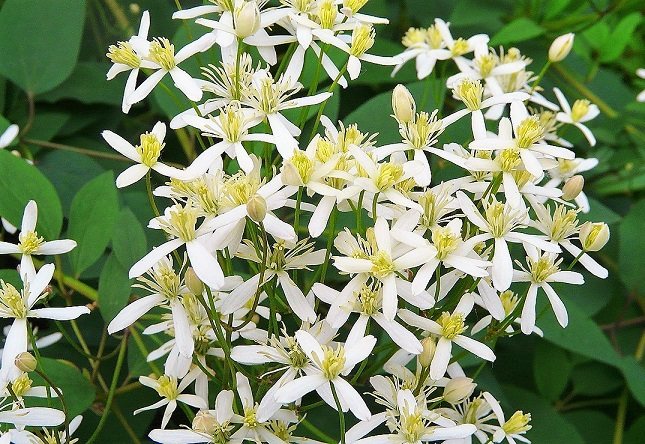
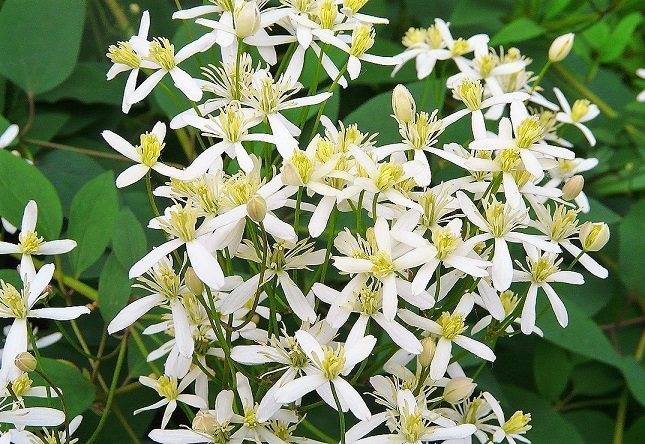
Flowers 1.5 – 2 cm in diameter, white, in numerous axillary inflorescences, drooping. Sepals 4. Blooms in August – October.
Shoots freeze annually in winter, in spring they resume from the root collar, grow up to 3 – 3.5 meters and bloom profusely. Propagated by seeds, dividing a bush or cuttings.
In vertical gardening, clematis is valued for its fast growth, large dark green foliage, foliage density and abundant long flowering.
Viticella group (Viticella)
Clematis of this group are tree climbing vines. They grow up to 4 meters high and are abundantly covered with flowers. The buds bloom on fresh shoots that have grown after pruning. This group of clematis can survive the winter without shelter.
Ville De Lyon blooms in July-September, buds up to 15 cm in diameter. Flowers are scattered evenly over the bush – from bottom to top.
Etoile Violette is small-flowered, with buds only 6-10 cm in diameter. You need to grow on the most lighted area.
Clematis Purpurea plena elegans has small (4–5 cm in diameter) but very bright double flowers. The bush is continuously fragrant from June to September.
Latest news
Chainsaw or electric saw – what to choose for the garden? 4 mistakes when growing tomatoes in pots, which are made by almost all housewives Secrets of growing seedlings from the Japanese, who are very sensitive to the earth
Blue angel has one peculiarity: it begins to bloom profusely only 4–5 years after planting. Then the bush will delight with beauty for a long time. It blooms profusely even after full pruning.
The Avangard variety is distinguished by very small (up to 5 cm), but very unusual and bright flowers. If you plant a bush in the shade, the buds will be more “juicy”, as they fade in the sun.
Clematis Dark eyes are small-flowered (5–6 cm in diameter), they look better on a light background, for example, on a white wall.
The peculiarity of the Madame Julia Correvon variety is that it blooms for a very long time and abundantly. Clematis is not cold-resistant, therefore it requires careful shelter for the winter.
The Nikitsky pink variety blooms twice a year, but the second time is not very abundant. The diameter of the buds reaches 10 cm.
Clematis Rubra differs from the others in very small leaves. Because of this, the flowers are more noticeable on the bush, their diameter is 6-7 cm. The variety is great for gazebos and verandas.
Clematis ligusticifolia Nutt
Clematis is common in North America, California, Colombia, Mexico. Liana up to 6 meters high. The stems are powerful. Leaves are dense, tough, yellowish-light green, unpaired-pinnate, with 5 – 7 leaves. Leaflets are pointed, up to wedge-shaped at the base, coarsely toothed, often three-lobed, 3-7 cm long, 3 cm wide.
Flowers are dioecious, white, up to 2 cm in diameter, collected in terminal or axillary multi-flowered shields.
Achenes 4 mm long and 2.5 mm wide, densely pubescent with a pinnately pubescent nose up to 7 cm long.
Blooms profusely from late July to mid-September. Selectively bears fruit in October – November. It propagates well by seeds. Very decorative look. It is valued for its many delicate leaves and abundant and long flowering.


After flowering, it is decorative with an abundance of fluffy fruits. It is used in vertical gardening up to a height of 6 meters.
Clematis paniculata (Climatis paniculata Thunb)
The homeland of the plant is Japan, Korea. Large liana up to 10 meters. Leaves are trifoliate or pinnate with 3 – 5 leaflets. Leaflets are oval, up to 3-10 cm long, mostly pointed, cordate or rounded at the base, usually entire, sometimes lobed.
Flowers up to 3 cm in diameter, white, fragrant, in numerous terminal and axillary paniculate inflorescences. Sepals are elongated.

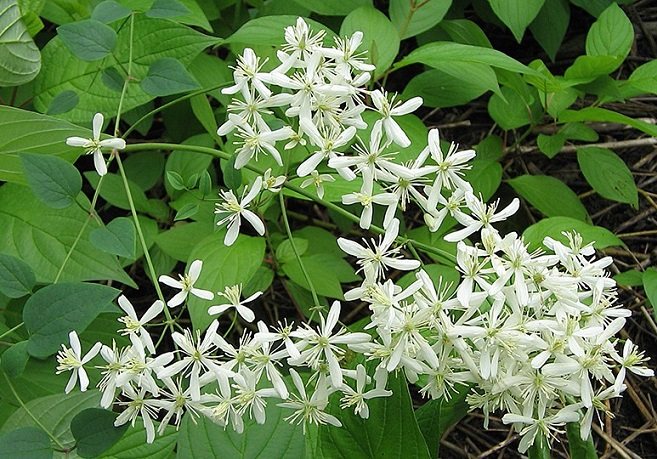
Achenes with a long pinnately pubescent nose. Blooms in September – November.
Grows best in rich, moist soils. In winter, the shoots freeze slightly, but in spring they resume from the preserved buds of the lower part of last year’s shoots and grow up to 3 – 3.5 meters in height and bloom profusely.
It propagates well by seeds, layering, green and lignified cuttings. In vertical gardening, it is valued for its rapid growth, powerful coating of the structure being designed, beautiful dark green leaves, late and abundant flowering.
Lanuginosa group (Lanuginosa)
These clematis are shrub vines. Shoots grow up to three meters in length. They are pleasing to the eye twice a year: in spring, flowers bloom on last year’s stems, and in summer – on fresh ones. The group is distinguished by large buds reaching 15–20 cm in diameter.
The Anna German variety is distinguished by abundant flowering. Buds with a diameter of 15 cm appear in the third year of planting.
For clematis of the Ball of Flowers variety, the largest number of buds appears on last year’s shoots, so they should not be cut off. The bush does not grow higher than 2 meters.
The Ballerina variety will delight you with flowers from July to September, their diameter reaches 15 cm. It is imperative to preserve last year’s shoots.
The Ideal variety fully lives up to its name. Clematis blooms all summer, the buds are large, the plant itself does not need annual pruning, it winters well.
The Lavsoniana variety is good for abundant flowering twice a season and large buds – up to 23 cm in diameter. Liana grows up to 5 meters in length, requires pruning.
The peculiarity of the Nadezhda variety is that it blooms very profusely twice a season, even with full annual pruning.
Variety Seagull small-flowered, up to 13 cm in diameter, but there are a lot of buds on the bush. Clematis remains decorative from spring to late September.
Purple Clematis (Clematis viticella L.)
Clematis grows in the Caucasus, Europe, Asia Minor, Iran. It grows more often on rocky slopes. This is a wooden liana up to 4 meters high. The stem is creeping, thin, hexagonal, purple with the most intense coloration at the nodes. Leaves, as a rule, are doubly pinnate, with 5 – 7 leaflets, trifoliate leaflets on petioles, slightly leathery. The lobes of the leaflets are ovoid or round, from 1.5 to 5 cm long, with slight pubescence below, intensifying along the veins.
Flowers are apical or axillary, bisexual, 1 – 3 on pedicels, up to 10 cm long, wide open, up to 5 cm in diameter, blue, purple, purple. Flower of 4 obovate sepals, up to 3 cm long and 2.5 cm wide with wavy-toothed edges, short pubescent below.

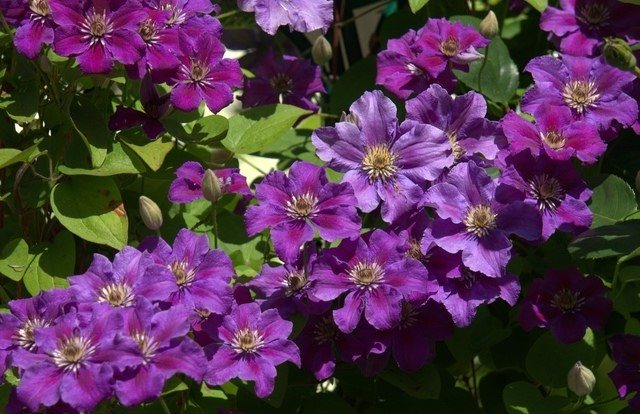
Filaments are almost naked. Achenes are rounded, up to 8 mm in diameter, flat, along the edge with a thickened border and a bare spiny nose, 3-4 mm long.
Shoots of a long type often freeze out in winter. In the spring they renew themselves from the root collar, so it is best to cut them off every fall. For 45 – 50 days, young shoots grow to the maximum height (4 m), in mid-June their growth stops, and at the end of June flowering begins, which continues until August. The seeds ripen in late September – October.
All varieties of purple clematis reproduce vegetatively. When propagated by seeds, strong splitting occurs without preserving the maternal form.
Can be used in any vertical gardening up to a height of 3 – 4 meters. It is valued for its fast growth, delicate foliage, abundant flowering and fruiting.
This type of purple clematis has varieties with flowers of various colors. Look at photos of some varieties:
Variety – Kermezina (Kermesina)
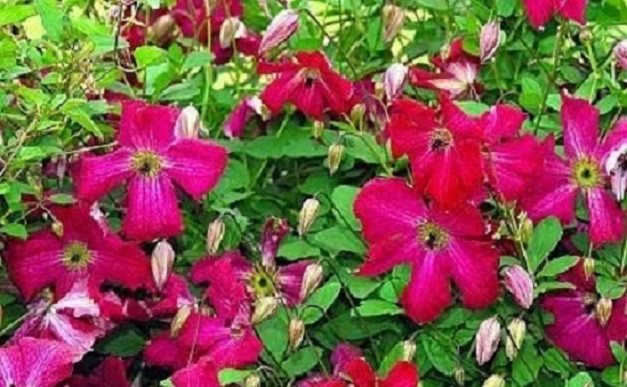
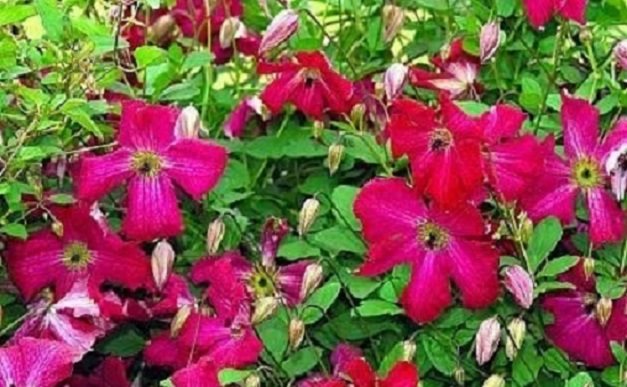
Wine red flowers, up to 8 cm in diameter. Sepals 4. Blooms very profusely from late June to early August. Sets seeds well.
Variety – Dwarf (Gnom)
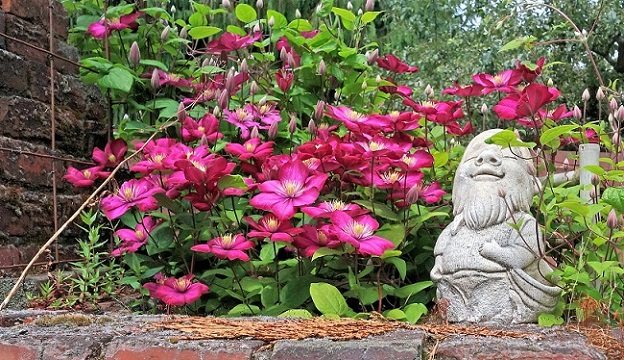

This vine is up to 2.5 meters high. Leaves are twice unpaired pinnate, with 3 – 5 leaflets 3 cm long and 1.5 cm wide. The flowers are red, 6 cm in diameter, with six sepals of regular shape. The flowering is very abundant.
Planting and caring for Zhakman’s clematis
The seedlings of Zhakman’s clematis can be transplanted to a permanent place in autumn or spring. The climatic conditions of the region have a significant impact on the dates of planting. In the south, seedlings can be planted in the second half of March or at the end of September. In the north, planting begins in mid-April or late August. The main thing is that the soil is warm enough by the time of planting.
Jacqueman’s Clematis love spacious spaces. Therefore, when planting them, it is important to maintain a distance between seedlings of 1 – 1,5 m. Some gardeners recommend digging special fences made of roofing material around the holes for planting underground, which do not allow plants to suppress the growth of each other.
Selection and preparation of the landing site
Jacquemann’s clematis grow well near arches and arbors, gracefully wrapping around the proposed supports. They can climb trees and bushes. Some undersized varieties of Zhakman’s clematis can be grown in a container on the balcony.
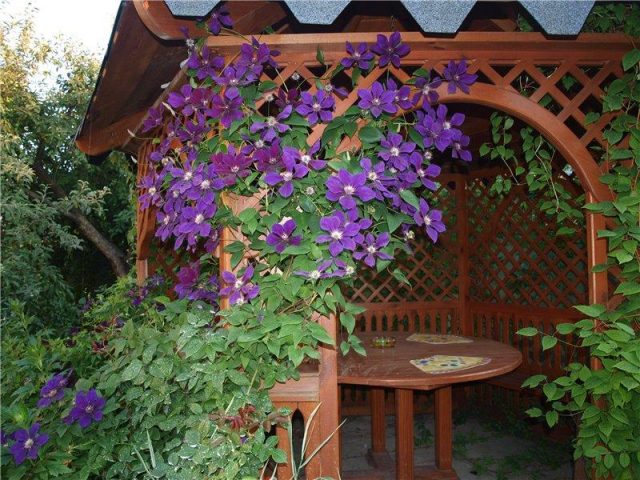
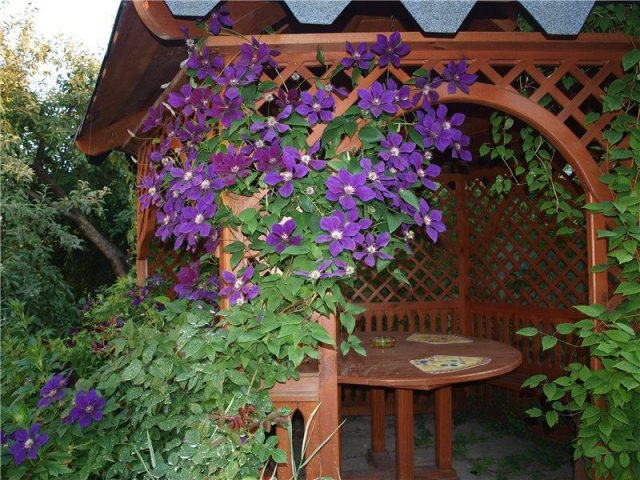
A sunny area is suitable for planting in the ground, however, the root zone of clematis should be slightly shaded. It is better to choose an elevated place so that long roots do not die due to the close location of groundwater.
The plant is often planted along buildings in such a way that there is a slight indentation from the walls. If you place the bushes too close to the walls, during the rain they will get water from the roofs, which can cause waterlogging of the soil.
First of all, for future clematis bushes of Zhakman, you need to prepare a soil mixture, which usually includes the following components:
- humus;
- peat;
- sand;
- superphosphate;
- dolomite flour.
Seedling preparation
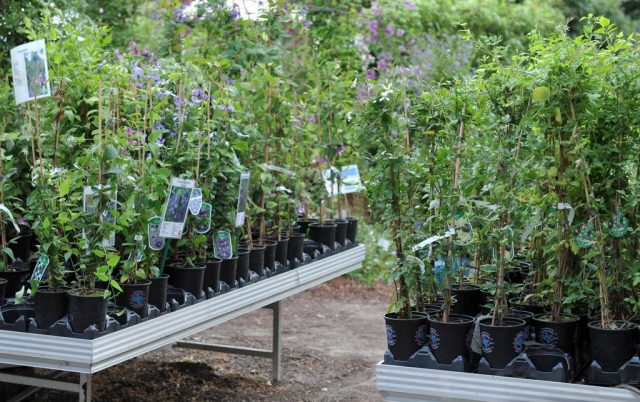

As you can see from the photo and description of Zhakman clematis varieties, they all differ greatly in appearance and flowering time. When buying, seedlings should be chosen taking into account the climatic conditions of the region, while preference is given to zoned varieties. When choosing seedlings, you also need to build on the planned place of planting. So, tall plants are best placed near gazebos and various supports, while lower ones can be grown even on the balcony.
Important! There should be no spots, signs of wilting or rot on the surface of the seedlings. For seedlings with a closed root system, the soil should be moist and clean.
Shortly before planting, the preparation of seedlings begins:
- seedlings of Zhakman clematis in containers are carefully removed, for which the soil must be abundantly moistened in advance;
- seedlings with an open root system are soaked in warm water for several hours.
Rules of landing
The size of the planting pits depends on the volume of the earthen coma of the plant. The average recommended dimensions are 60x60x60 cm.At the same time, the distance from fences, walls and other buildings should be at least 30 cm.
Algorithm for planting clematis Zhakman:
- drain the bottom of the planting pits with broken brick or small stone;
- fix a support for a plant with a height of at least 2,5 m;
- pour a small amount of soil mixture onto the drainage layer, forming a mound;
- place the seedling in the hole, gently spreading the roots;
- fill the seedling with the remaining soil mixture, deepening the root collar and part of the trunk under the ground;
- compact the soil with your hands and water.
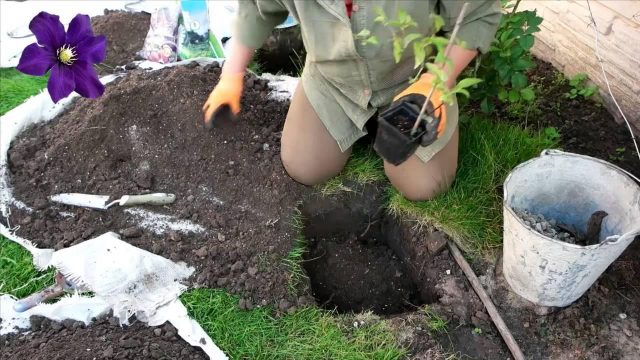
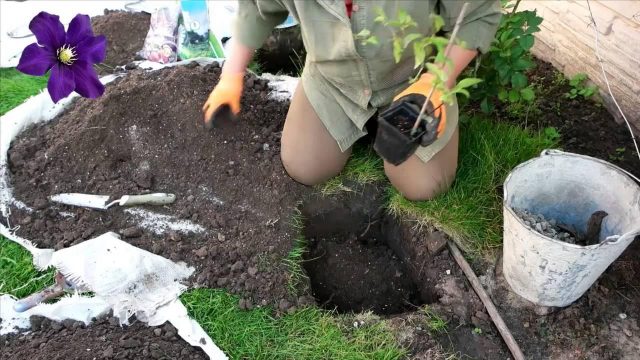
Watering and top dressing
Clematis Jacques are quite hygrophilous, they need abundant and regular watering. It is best to do this once a week, pouring 1-30 liters of water onto 40 bush, however, in case of drought, the number of irrigations is increased to 2 or 3, as needed. The best time to water is evening.
In the first year, young clematis seedlings are not fed, since the necessary fertilizers are usually applied during planting. The next year, you can already start fertilizing the plants. During active growth, nitrogen fertilizers are applied, during the formation of buds – potassium fertilizers. When the flowering process is over, it is recommended to add phosphorus fertilization.
Mulching and loosening
The soil surface around the clematis bush is regularly loosened. All weeds are removed. Loosening the soil and removing weeds improves the access of the roots to oxygen.
To allow moisture to evaporate from the soil surface longer after watering, clematis mulch. Peat is often used as mulch.
Clematis blooming “Duchess of Edinburgh” (Clematis florida “Duchess of Edinburg” Jackman)
Liana grows up to 4 meters high. The leaves of the upper part of the shoot are trifoliate, the lower ones are double-trifoliate, ovate-lanceolate with a rounded base, gradually emerging into a sharp apex, glabrous, dark green above.
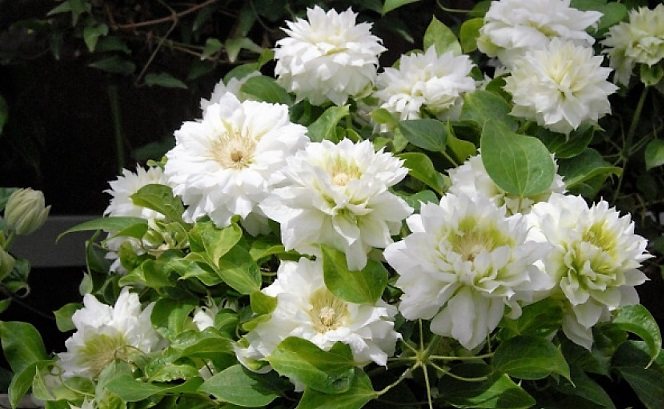
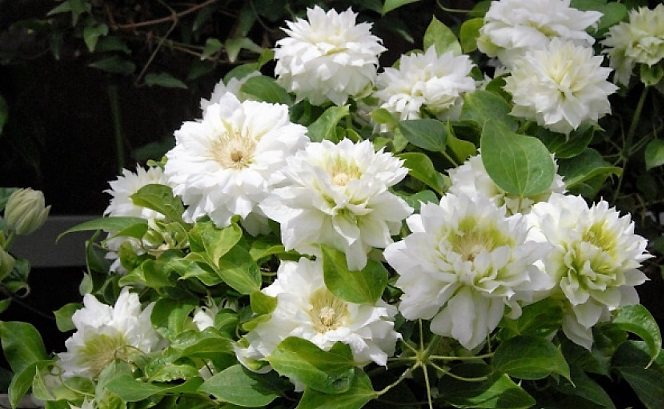
Flowers are white, double, up to 12 cm in diameter. It blooms on the shoots of last year from June until frost. Sometimes at the tips of the sepals, leaf metamorphosis appears. Flowers on the shoots of the current year are less double and bloom later. Reproduces only vegetatively.
Clematis: botanical reference
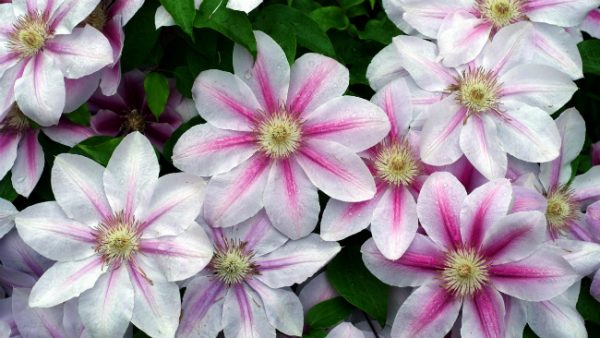

Lomonosas are beautiful flowers that grow over 15 meters.
Clematis (clematis) is included in the extensive Buttercup family. In nature, the plant is found in the subtropical and temperate zones; in total, about 300 varieties of clematis are known.
The genus includes ornamental shrubs and climbing vines, mainly clematis with a liana-shaped stem are grown, which are used for landscaping small architectural forms, gazebos, pergolas and verandas. The plant grows well in winter gardens and open field.
Different species of clematis are very different from each other in the structure of the root system (pivotal or fibrous); the size of the flowers; type of pruning and a number of other signs.
Among the plants, you can find specimens with large and small flowers of a simple or double shape. The petals range from pure white to dark purple. Often the corolla of a flower has a multicolored color, contrasting stripes on the petals or a spot in the center.
Usually the plant height is 2 to 4 meters, the flower diameter is up to 15 cm.
Woolly Clematis (Clematis lanuginosa L.)
Liana grows up to 3 meters high. Young shoots are covered with hairs. The leaves are simple or trifoliate, the leaves are leathery, ovate, with a rounded or heart-shaped base, peaked, at first tomentose, then dark green and glabrous.
Flowers are single or 2 – 3 on a stem 5 – 10 cm long, with flat-spaced sepals, up to 15 cm or more in diameter. Sepals 6 – 8. Flowers of various colors, more often white and blue tones.
Anthers are mostly colored, of the same length with stamens. The fruit has a long (up to 6 – 7 cm) hairy crest. Flowers on the shoots of the last year appear in May – June, and on young ones – in July. Blooms until frost.
In winter, the shoots freeze out, therefore, it is necessary to make a buried planting by 10 – 12 cm. The buds of the shoots, which are in the ground, are preserved, and in the spring they grow powerful young shoots.
Many highly decorative varieties with large flowers of various colors, which are close to each other, have been bred from woolly clematis.
Variety – Lawsoniana

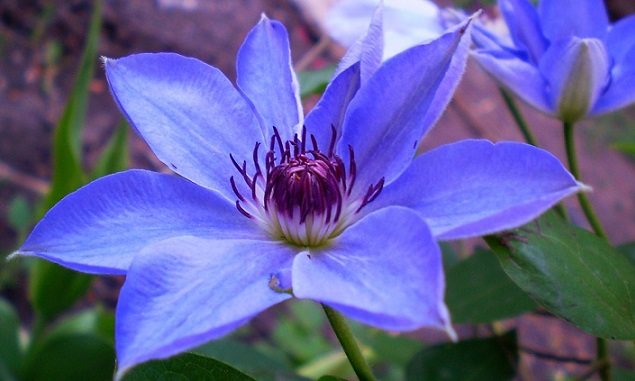
The flowers are pale blue
The flowers are pinkish-blue, up to 14 cm in diameter. Sepals 6 – 8.
Variety – Lux (Luks)

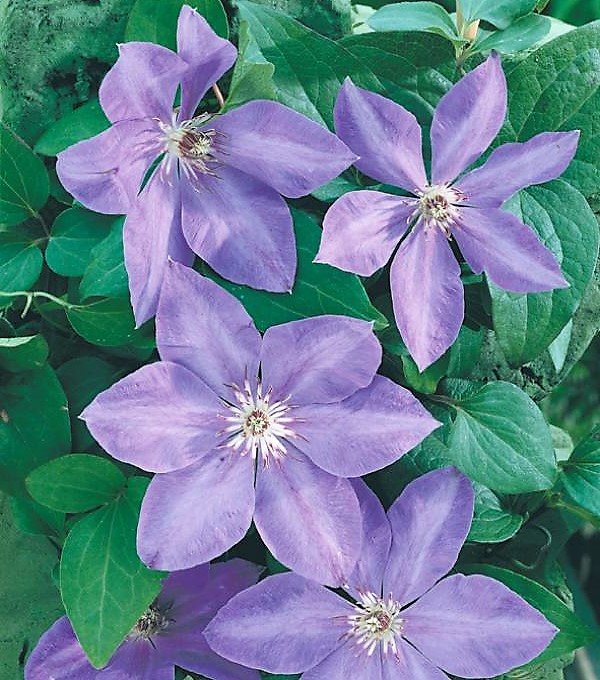
Liana 3 meters high. The flowers are purely deep blue, up to 12 cm in diameter, with six regular sepals. Abundant flowering.
Clematis varieties of the Zhakman group
There are many different varieties of Zhakman clematis: photos of crops show that they all differ in size, color and shape of flowers, appearance of leaves and length of shoots. The article lists the most popular varieties of Zhakman’s clematis recommended by Russian gardeners.
Important! Some varieties of clematis have similar names, but, at the same time, do not belong to the Zhakman group. So, for example, Clematis Zhakman Alba belongs to the Florida group, and clematis Barbara Zhakman belongs to the Patens group.
Superba
Clematis Zhakmana Superba is a shrub deciduous vine that can grow up to 3 m in length. The inflorescences are wide open, velvety, consist of four deep purple petals, have slightly greenish anthers. In the center of the petals there is a purple stripe that fades with aging of the flower. Collected in the axils, several pieces of clematis buds of Zhakman Superba look like a half-umbrella.
Flowering usually begins in May and ends in September. Cold weather can delay flowering times. The variety is characterized by an average winter hardiness.

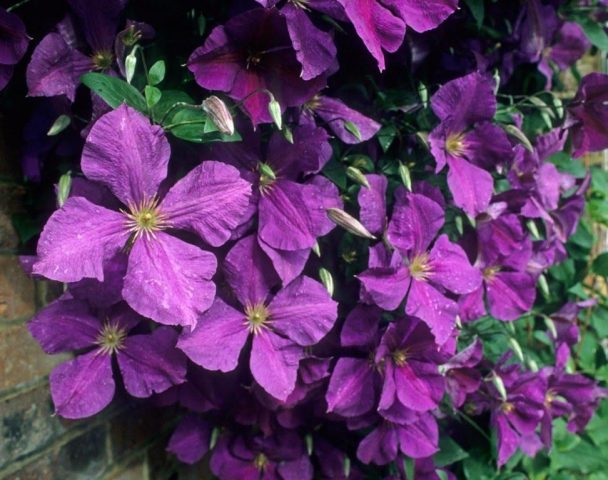
Rouge cardinal
Clematis Rouge Cardinal is a hybrid variety from the Jacquemand group, a French breeder development that has received many world awards. The dark purple velvety flowers of the liana are quite large, their diameter is approximately 15 cm.The inflorescences themselves are cruciform. The flower is complemented by contrasting stamens of a light, milky shade.
Shoots of clematis Rouge cardinal grow up to 2 – 2,5 m. Medium-sized leaves have a trifoliate shape. The leaf plate is colored dark green. The plant blooms from July to September. The variety is considered moderately hardy.


Cosmic Melody
The Zhakman group also includes the Kosmicheskaya Melody clematis variety, developed by domestic breeders in 1965. The plant was named after the flights of Russian cosmonauts with a cosmic melody. It is a shrub vine that reaches a height of 3 m. The bush is usually formed from 15 to 30 shoots. According to the manufacturers, the Cosmic Melody variety has exceptional frost resistance.
One shoot can grow from 10 to 30 flowers. The diameter of the opened flowers is 12 – 14 cm. They consist of 5 – 6 velvety petals of a violet-cherry hue, having a diamond shape. The petals of the Cosmic Melody clematis do not adhere closely to each other: there is a certain distance between them. This arrangement can be considered a distinctive feature of the variety.
Important! The color of clematis petals in bright sun can become paler over time.
Luther Burbank
Luther Burbank is one of the varieties of clematis of the Zhakman group, which has perhaps the largest flowers, the size of which reaches 20 cm in diameter. Liana is also characterized by rapid growth, shoots stretch up to 2,5 – 4 m. The bush forms about 10 shoots.
One shoot of Clematis Luther Burbank contains 9 to 12 flowers. The flowers are painted in a violet-purple hue, have 5 – 6 pointed petals. The edges of the petals are wavy. The stamens are yellow-white. Flowering lasts from July to September. Clematis Jacquemann Luther Burbank is able to withstand frosts down to -30 degrees.


Anna Herman
Clematis Anna German is another variety of the Zhakman group, bred by domestic breeders in 1972 in honor of the famous Polish singer. Plant height is about 2 – 2,5 m. Liana blooms early, closer to mid-May. In favorable conditions, it can bloom again in August. Clematis Zhakmana Anna German is well adapted to the Russian climate, it can withstand even severe frosts down to -40 degrees.
The flowers of the plant are very large, from 16 to 20 cm in diameter, have a star-like shape. They consist of petals of a pale purple or pale lilac color. The color of the petals is lighter in the center and more saturated at the edges, the stamens are yellowish. The variety is considered to be moderately growing, so it can even be grown on the balcony in containers.


Gypsy Queen
Clematis Jacquemana Gypsy Queen is a shrub vine formed by about 15 shoots with a maximum length of 3,5 m. The plant can be grown in a container. A distinctive feature of the variety is considered to be slightly raised buds. The liana begins to bloom in late July or early August.
The size of the dark purple flowers of the liana is about 15 cm. The petals are velvety and wide enough. Anthers also acquire a purple color after the flower is fully ripe.
Important! Unlike many varieties of the Jacqueman group, the flowers of Clematis Gypsy Queen do not fade under the influence of the bright summer sun.

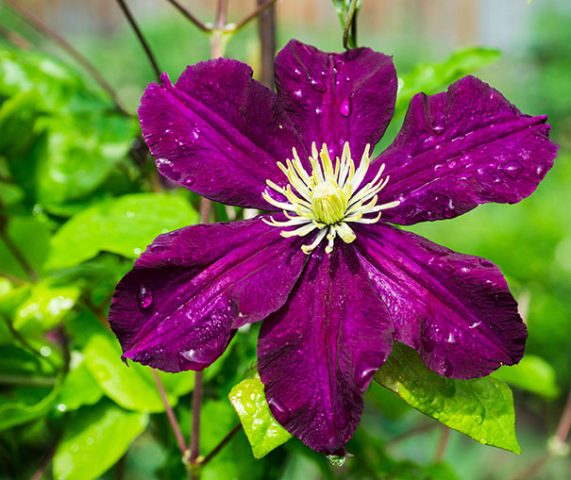
Nellie Moser
Clematis of the Nelly Moser variety is a deciduous vine from the Jacquemann group. The height of the plant is about 2 – 2,5 m. The flowers of the liana are painted in a very delicate, light, mauve shade. Anthers are two-colored: white and deep purple. There is a bright pink stripe in the center of the petals. In appearance, the petals resemble a slightly pointed ellipse. The shape of the flowers is star-shaped, with a diameter of 12 – 18 cm.
Vine blooms in May or June, re-flowering begins in August or September. The clematis variety Nelly Moser belongs to the 4th zone of winter hardiness and can withstand frosts down to -35 degrees.


Moonlight
In 1958, the clematis variety Zhakman Moonlight was bred by the Russian scientist A.N. Volosenko-Valenis. Liana is vigorous, shoots grow up to 3 m in length. Composite leaves are formed by 3, 5 or 7 leaves. Flowering begins in June or July. The culture is suitable for growing in all climatic zones of Russia.
Vine shoots are strewn with shiny lavender flowers with a transition to blue towards the center. The size of the flowers ranges from 8 to 12 cm. The flowers are often formed from 4 petals, much less often from 5 or 6. The shape of the petals is rhombic, with pointed ends, often bent outward. The stamens are light, pale green.

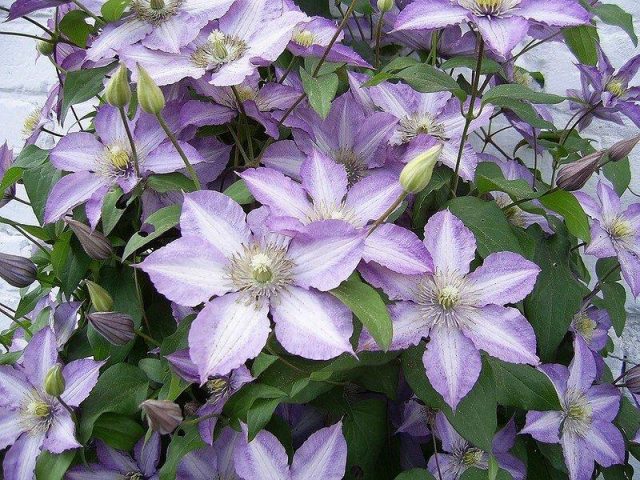
Texas
The clematis variety Zhakman Tex was bred in 1981 by the Estonian breeder U. Ya. Kivistik. Clematis Texs are not too tall, which allows them to be grown in containers on the balcony. Vine blooms in June or July, re-flowering should be expected in early September.
The size of the flowers is 14 cm in diameter. The petals are distinguished by wavy edges and pointed tips. The flowers consist of 6 petals, painted in a bluish color, resembling rubbed denim in appearance, since the surface of the petals is evenly strewn with light blotches. Anthers have a grayish purple hue.


Ernest Markham
Clematis Ernest Markham is one of the most popular varieties of the Jacquemann group, bred in 1936 and is still famous for its bright raspberry inflorescences. This is a perennial liana, the maximum length of shoots of which is 3,5 m. This variety of clematis is very frost-resistant and can withstand temperatures down to -35 degrees.
The flowering of this vine is quite long, lasts from June to August. The flowers are large, up to 15 cm in diameter, formed by 5-6 overlapping velvet, wavy, slightly pointed petals. The stamens are cream-colored.
